Abstract
Diagenesis is one of the factors that affect reservoir quality in sandstones. Knowledge of diagenetic transformation and how it impacts the development of porosity in reservoirs rocks is thus key to successful mineral exploration. To date, little is known about the diagenesis of the uranium-hosted sandstones of the Stormberg Group, Karoo Basin, South Africa. Petrographic study, scanning electron microscopy (SEM) aided with energy dispersive X-ray (EDX), and X-ray diffraction (XRD) analyses were employed for the diagenetic study of the sandstones. This study aims to provide an account of the diagenesis of these rock units and how it impacts their reservoir quality. The diagenetic processes that have affected the sandstones are cementation, compaction, recrystallization, replacement, mineral overgrowth and dissolution. These processes have passed through early, late and uplift-related diagenesis. Formation of authigenic minerals and precipitation of the mineral cements occurred during different diagenetic phase but mostly during the early diagenetic stage. This stage was followed by lithification, which resulted in increased in grain packing, loss of pore spaces and thinning of bedding. Quartz and feldspar overgrowths, chloritization, muscovitization, concave-convex contacts, recrystallization, albitization and suture contacts are present in the late diagenetic stage. The uplift-related diagenetic stage was affected by calcitization, grain deformation and fracturing, dissolution and saussuritization. All these diagenetic processes largely affected the porosity and permeability of the sandstones. Primary and secondary porosities were both observed in the sandstones. In general, there is no single diagenetic process that is controlling the pattern of porosity evolution in the sandstones. On the other hand, the presence of fractured and dissolution pores tend to increase the porosity, thus enhancing the reservoir quality. This study shows that diagenesis has significantly altered the original petrologic characteristics of the sandstones which have induced considerable deterioration and heterogeneity in the reservoir quality of the Stormberg Group sandstones in the Main Karoo Basin of South Africa.
1 Introduction
Diagenesis affects sediments after their deposition and during or after their lithification, thus influencing the amount and distribution of porosity and permeability in sedimentary rocks. Diagenesis includes a fundamental suite of physical, chemical and biological processes. These processes control the texture, mineralogy and fluidflow properties of sedimentary rocks [1]. Porosity and permeability in rocks (i.e. sandstone) may be destroyed or preserved or/and enhanced by diagenesis [2]. Porosity and permeability are initially influenced by the depositional environment and thereafter controlled by diagenesis. Hence, understanding the processes and products of diagenesis is therefore a key aspect in the evolution of sedimentary basins, and affects the destruction, preservation and generation of porosity [3]. Recent studies and progresses in diagenetic study have resulted in more accurate estimates or predictions of sandstone reservoir quality. Petrographic studies are important for characterizing the types, timing and rate at which diagenetic processes affect porosity and permeability in sandstones [4]. In most cases, reservoir quality and heterogeneity of sandstones are functions of primary depositional factors (i.e. mineral composition, grain size and sorting etc.) and secondary diagenetic modifications [5].As documented by [6], these depositional factors tend to control the depositional porosity and permeability of the sandstones and subsequently affect the types and extent of diagenetic alterations. On the other hand, diagenetic modifications usually bring out the changes or variations in the depositional porosity and permeability. As burial depth increases, porosity and permeability are often reduced by compaction and cementation, enhanced by dissolution, and preserved by processes like grain coatings [2, 7, 8]. Burial diagenesis processes alter/or change and eventually determine the porosity and permeability of the reservoir, hence having a significant impact on the clastic reservoirs quality [4]. The relationships between these processes resulting in the formation of reservoirs with a wide range of porosities and permeability is documented by researchers like [2, 8, 9, 10]. However, the main factors affecting diagenesis are not well understood and diagenetic changes or modifications in reservoir properties remain highly unpredictable since a variety of diagenetic processes and products are very high in clastic sediments, particularly sandstones [11].
The Stormberg Group is the name assigned to the sedimentary geological formations of the Late Triassic to Jurassic Period, found in the southern Karoo basins. Sedimentation of the Stormberg Group is related to different basins in which sediments accumulated during the Late Triassic. The Stormberg siliciclastics are widely distributed over southern Africa; the basin roughly covers an oval-shaped area in the Eastern Cape Province of South Africa, extending northwards into the Free State, KwaZulu-Natal and Lesotho [12]. Diagenetic changes in the Stormberg siliciclastic rocks have huge influence on reservoir quality by modifying the rock’s original porosity, permeability and mineralogy. In South Africa, uranium-enrichment in the Stormberg Group has been recorded in the fluvially-deposited sandstones [13]. According to [14], this uranium perhaps might have been derived from granitic terranes to the south-east in the Main Karoo Basin and transported and deposited owing to entrainment, adsorption onto clay minerals or in solution. The efficient exploitation of this mineral deposits depend on several factors, including better understanding of the impact of diagenetic alterations on the host sandstones. To date, there are very few published studies on the diagenesis of the clastic rocks from the Stormberg Group in the whole of southern Africa. The purpose of this study is to examine if diagenesis has significantly altered the original petrologic characteristics of the Stormberg Group sandstones after deposition as well as the impact of diagenesis on their quality as potential clastic reservoirs. The study focuses on the cement types, pore types, and sequential diagenetic transformations and associated mineral assemblages in the sandstones of the Stormberg Group.
2 General geology and stratigraphy
The Main Karoo Basin is a large sedimentary depository lying north of the Cape Fold Belt in South Africa [15]. The basin developed within the “continental interior of southwest Gondwana” [16, 17] and covers up to 700, 000 km2 [18], but it was broader or wider during the Permian [19]. It represents about 117 Ma of sedimentation spanning from 300 Ma to 183 Ma [18]. The Karoo Basin covers almost half of the present surface of South Africa and encompasses the great Gondwana succession of glacial, marine, deltaic, fluvial and aeolian sedimentary units capped by Jurassic basalts [20]. [15, 21] are of the view that the Karoo sediments were accumulated within an intracratonic retro-arc foreland basin and that a number of processes influenced the depositional settings including different climatic regimes. The tectonic activities that took place were in response to the subduction of the Paleo-Pacific plate beneath the Gondwanan plate, and this triggered basinal subsidence which facilitated the building of the adjacent Cape Fold Belt [22]. The glaciers that covered the Karoo Basin during the Carboniferous-Middle Permian Period started retreating resulting in high sedimentation which filled the basin in a deep-water environment [15]. [23] interpreted the tectono-sedimentary evolution of the Karoo Basin by dividing it into a pre-foreland and foreland phase. According to these workers, the pre-foreland Karoo Basin that comprises of the Dwyka, Ecca and lower Beaufort Groups developed within the continental interior of Gondwana due to vertical movement of rigid or firm blocks and intervening crustal faults. The foreland Karoo Basin (comprising of the upper Beaufort Group) developed as a response to the uplift of the Cape Fold Belt during the Early Triassic. The sedimentation that occurred in the retroarc foreland setting (Karoo Basin) was controlled by the orogenic cycles of loading and unloading in the Cape Fold Belt [15]. As documented by [24], the sedimentary part of the Main Karoo Basin of South Africa comprises of the Dwyka (Late Carboniferous-Early Permian), Ecca (Permian), Beaufort (Late Permian-Triassic) and Stormberg Groups (Late Triassic-Early Jurassic, Table 1).
The Stormberg Group is an informal stratigraphic division name, which is made up of three formations, namely, Molteno, Elliot and Clarens Formations (Figures 1 and 2). The study area extends from longitude 26° 30’ E to 28° 15’ E and latitude 31° S to 32° S (Figure 1). It covers the areas from Indwe, Elliot, Rossouw, Dordrecht, and Barkly East in the Eastern Cape Province of South Africa. Greater parts of the Molteno, Elliot and Clarens Formations are exposed in areas around Indwe, Elliot and Rossouw, respectively (Tables 2-8). Much of the Clarens massive sandstone beds and aeolian dune sediments are exposed in the Barkly East area. The Triassic Molteno Formation was deposited within braided river channels and resulted in the formation of conglomerate, sandstone, shale and mudstone as well as coal seams [25, 26]. The Molteno Formation can be subdivided into the basal Boesmanhoek Member, the Indwe Sandstone Member and the upper Kramberg Member [27]. The Elliot Formation that overlies the Molteno Formation comprises of lateral continuous floodplain mudstones and associated fluvial sandstones. The sandstones of the Elliot Formation are often coarse and gritty at the base, very persistent and also calcareous [12, 28]. The strong red or purplish colouration, distinguishes the Elliot Formation from the Molteno Formation below and from thewhite and cream coloured Clarens Formation that overlies it ([28]; Figure 2).
Lithostratigraphy of the Karoo Supergroup in the Eastern Cape Province as compiled by the Council for Geoscience (After [18, 24]).
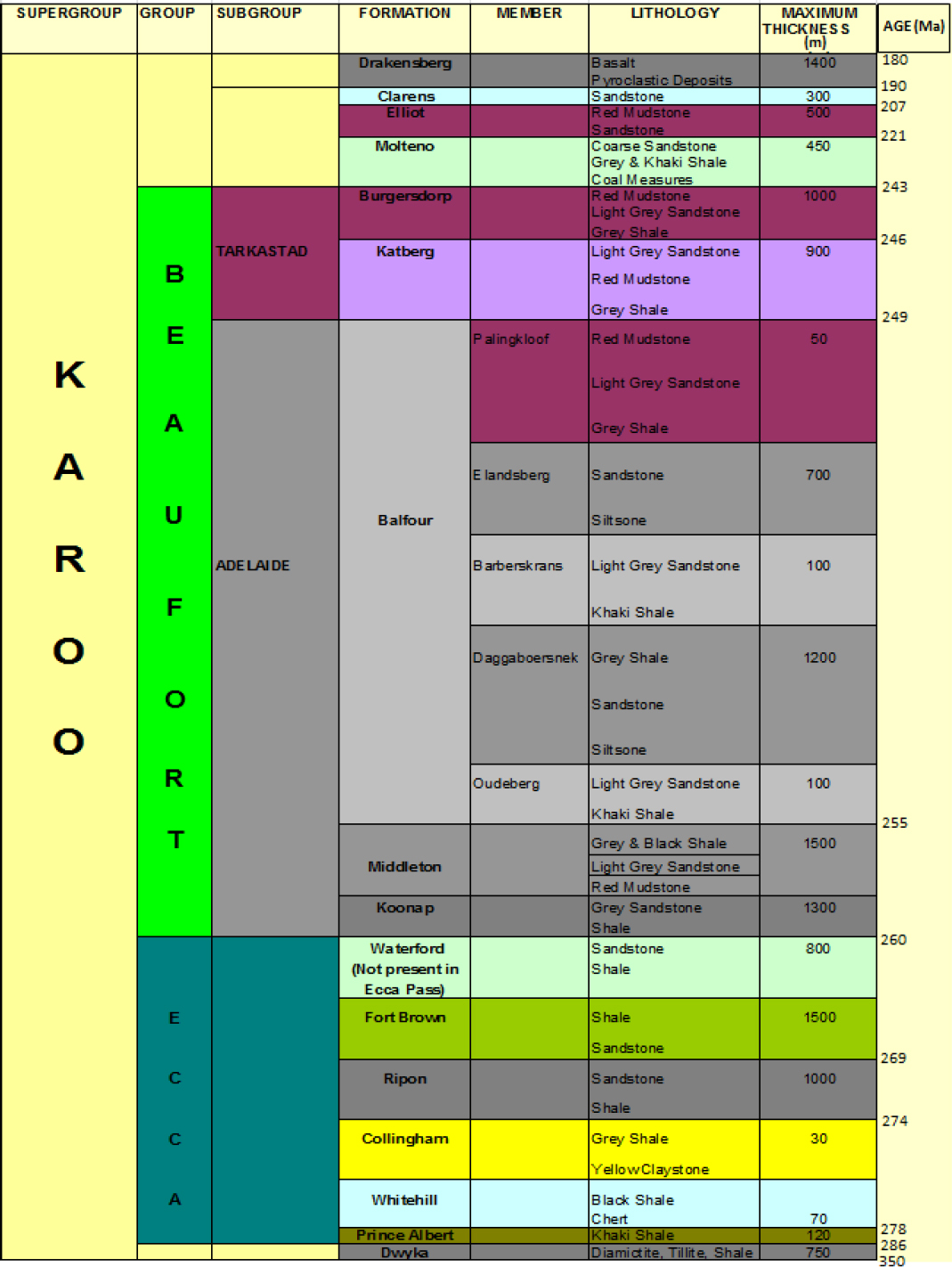 |
![Figure 1 Geological map showing the study area and areal destributions of lithostratigraphic units in the Main Karoo Basin (After [15, 33]).](/document/doi/10.1515/geo-2018-0059/asset/graphic/j_geo-2018-0059_fig_001.jpg)
Geological map showing the study area and areal destributions of lithostratigraphic units in the Main Karoo Basin (After [15, 33]).
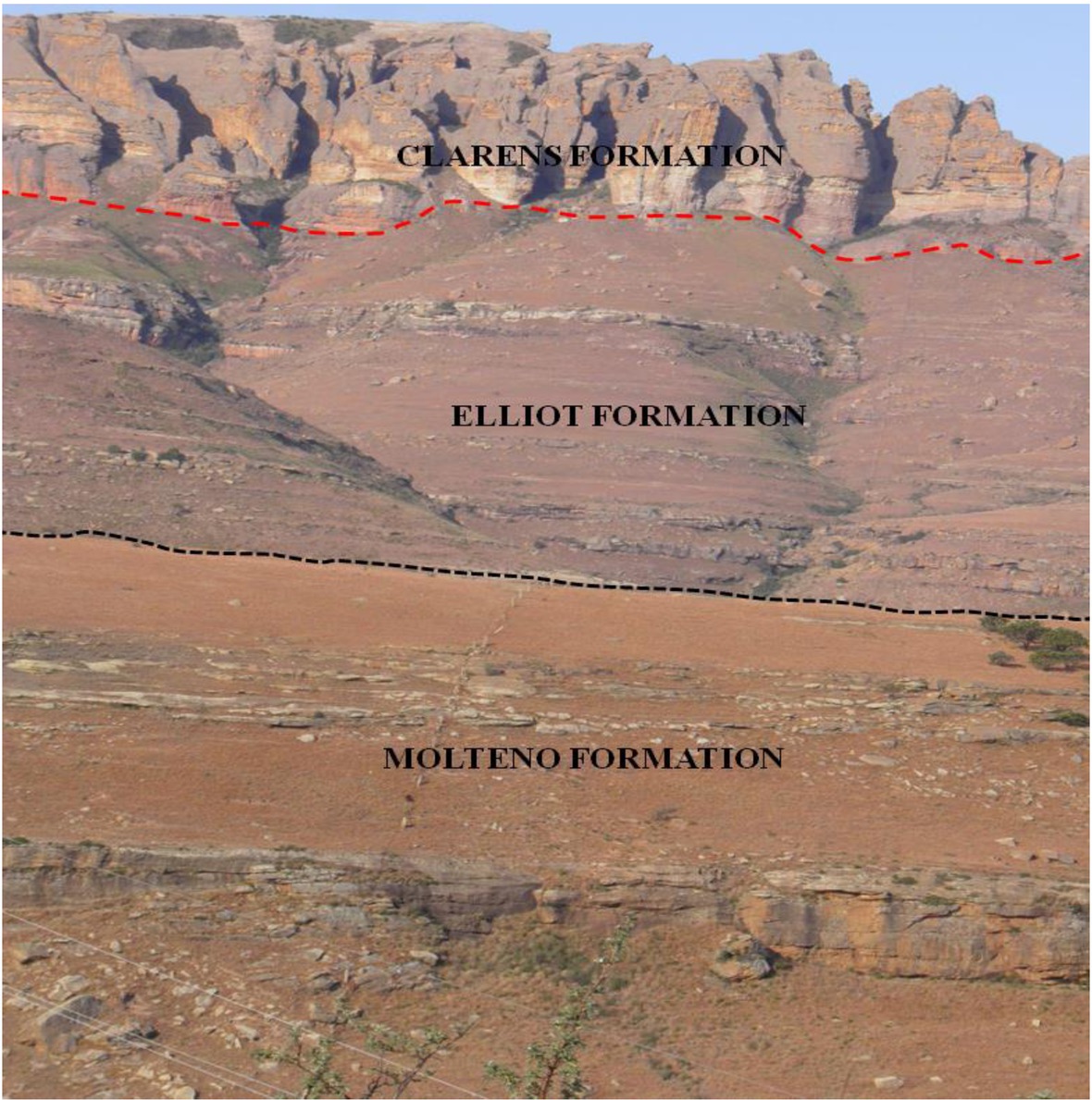
Field outcrop photograph showing the Molteno, Elliot and Clarens Formations around Barkly Pass, in the Eastern Cape Province of Sounth Africa (S31° 14.679’, E27° 49.408’).
The Late Triassic to Middle Jurassic basin fill habitually lacked drastic lateral facies changes such as thickness variations, resulting in only two major lateral changes along the south-north profile [29]. The southern boundary of the present preserved area of the upper Karoo strata further defines the southern limit of the “Stormberg” basin situated north of Queenstown [15]. Much of the northern boundary of the Basin is believed to have been removed by post Karoo erosion [28]. According to [15], the Elliot Formation was deposited when the proximal sector of the system was uplifted, eroded and the reworked sediments were transported into the distal sector which acted as a depositional foresag. The Elliot Formation sequence highlights that depositional energy greatly reduced with time and that aeolian conditions prevailed towards the end of the Elliot deposition [30]. A transitional zone of alternating sandstone and shale beds with an increasing sandstone/shale ratio is formed towards the top of the Elliot Formation [31]. The transition zone represents the beginning of aridity and spreading aeolian sands [31].
The Clarens Formation is the youngest sedimentary deposit in the Karoo Basin. The Clarens Formation that overlies the Elliot Formation represents the final stage of the aridification process. It consists of sandstones and sandy siltstones formed from aeolian processes [15, 26]. The gradual change in climate resulted in uneven contact between the Clarens Formation and the underlying Elliot Formation and this has resulted in the presence of thin beds of red mudstones in the Clarens Formation and thin beds of sandstones in the Elliot Formation [30]. At some point, deposition of both formations took place at the same time due to gradual impingement of aeolian sands upon the area [30]. The mudstones and many thin lenses of sandstone and siltstone are generally brilliant red, especially in the upper part of the Elliot sequence. The red colour is due to the presence of haematite, derived from either pre-existing soils or from red beds, and it forms a coating of iron oxide (hematite) around the grains. The red colour generally indicates arid or semi-arid climate [32]. The Clarens Formation contains a central zone that indicates a true desert condition which is dominated by an aeolian dune environment and the westerly wind transported the sand [33]. As documented by [34], towards the final stage of deposition of the Clarens Formation, the climate became fairly moderate and wet desert processes of stream and sheet flood became more dominant [15]. The Clarens Formation is overlain by the basaltic lavas of the Drakensberg that forms the top of the Karoo sequence, and is believed to have terminated sedimentation within the basin in the Middle Jurassic [24].
3 Methodology
Field investigation was conducted on exposures of the Stormberg Group in the Eastern Cape Province to analyse the lithologies, measure the bed thicknesses and take fresh rock samples for analyses. A few outcrops around Indwe, Elliot, Rossouw, Dordrecht, and Barkly East were selected for this study (Figures 1-2; Tables 2-8). Thin sections of 84 representative rock samples collected from the field were prepared (thin slices of rocks were mounted with epoxy on glass slides and ground to a thickness of 35 microns) and studied under reflected and transmitted light microscope to determine their mineral compositions, rock textures, shape and size of grains as well as the cement types. Furthermore, a total of 20 samples were cleaned properly and glued on a glass microscope slide using Struers specifix resin mixed with Struers specifix-40 curing agent in the ratio 5:2 by weight. The mounted samples were left for 24 hours so that the samples get stuck to the microscope slide. After the samples had been stuck to the microscope slide, the samples were carbon coated with a Cressing Carbon Coater 108 machine and were analysed with the scanning electron microscope (SEM) equipment modelled as Jeol JSM-6390LV, with an accelerating voltage of 15kV. The SEM instrument was equipped with a link system Energy Dispersive X-ray micro-analyser (EDX). The samples were examined in secondary electron imaging (SEI) and backscattered electron (BSE) modes of imaging. Clay minerals, mineral alterations, diagenetic textures, pore geometry, mineralogy of the sandstones were described based on the petrographic microscopy, SEM and EDX analyses. SEM and thin sections petrographic study were carried out at the University of Fort Hare, South Africa. Mineralogy of the sandstones was also determined by X-ray diffraction (XRD) at the Council for Geoscience laboratory in Pretoria.
4 Results
4.1 Cementation
Cementation is the diagenetic process bywhich authigenic minerals are precipitated in the pore spaces of loose sediments. The cement types identified in the studied sandstones are quartz cement, calcite cement, smectite cement, kaolinite cement and hematite cement.
Measured stratigraphic profile of the Molteno Formation near Indwe (Eastern Cape: S 31° 27.196’, E27° 22.338’).
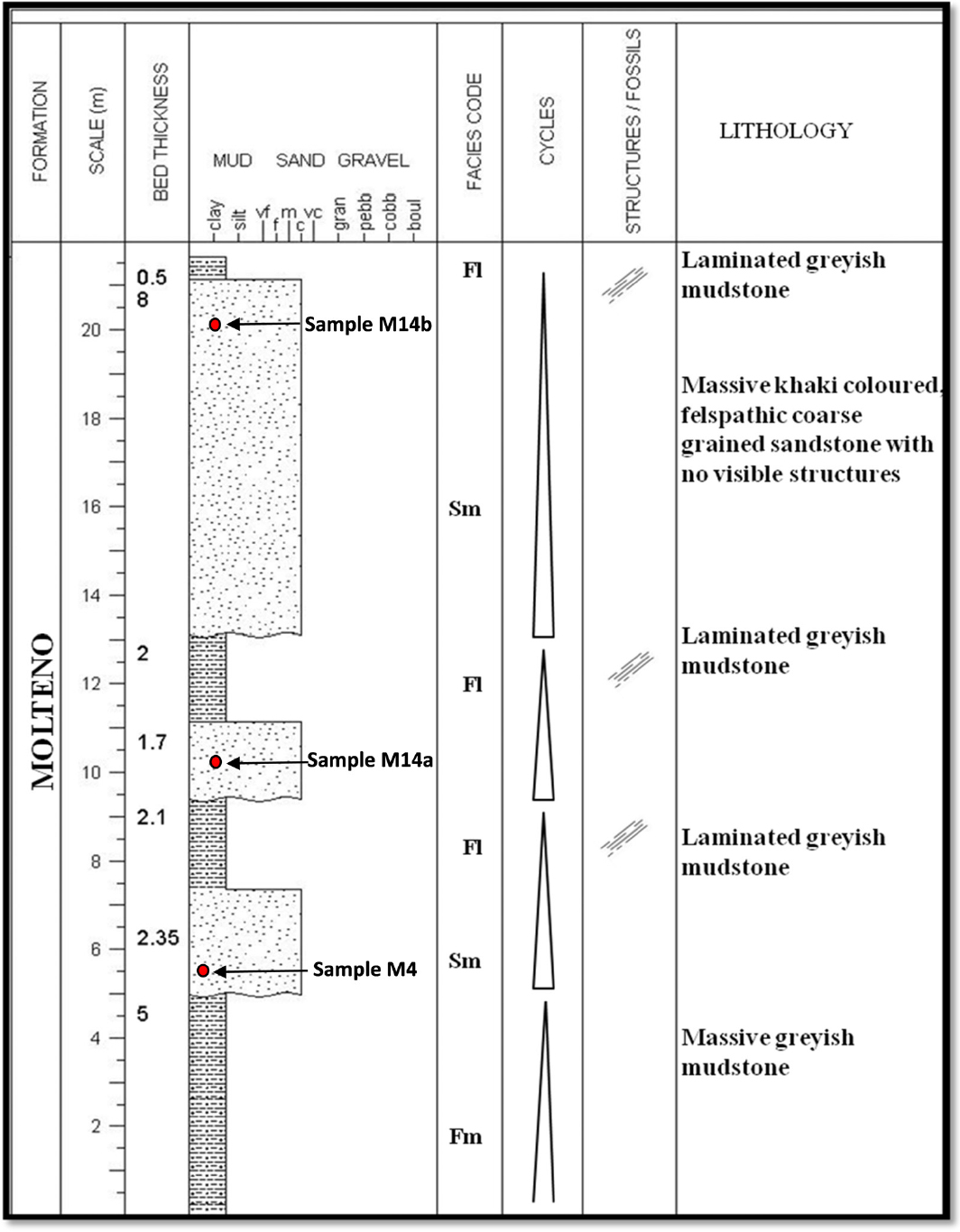 |
Measured stratigraphic profile of the Molteno Formation along Cala Pass (Eastern Cape: S 31° 36.928’, E27° 27.932’).
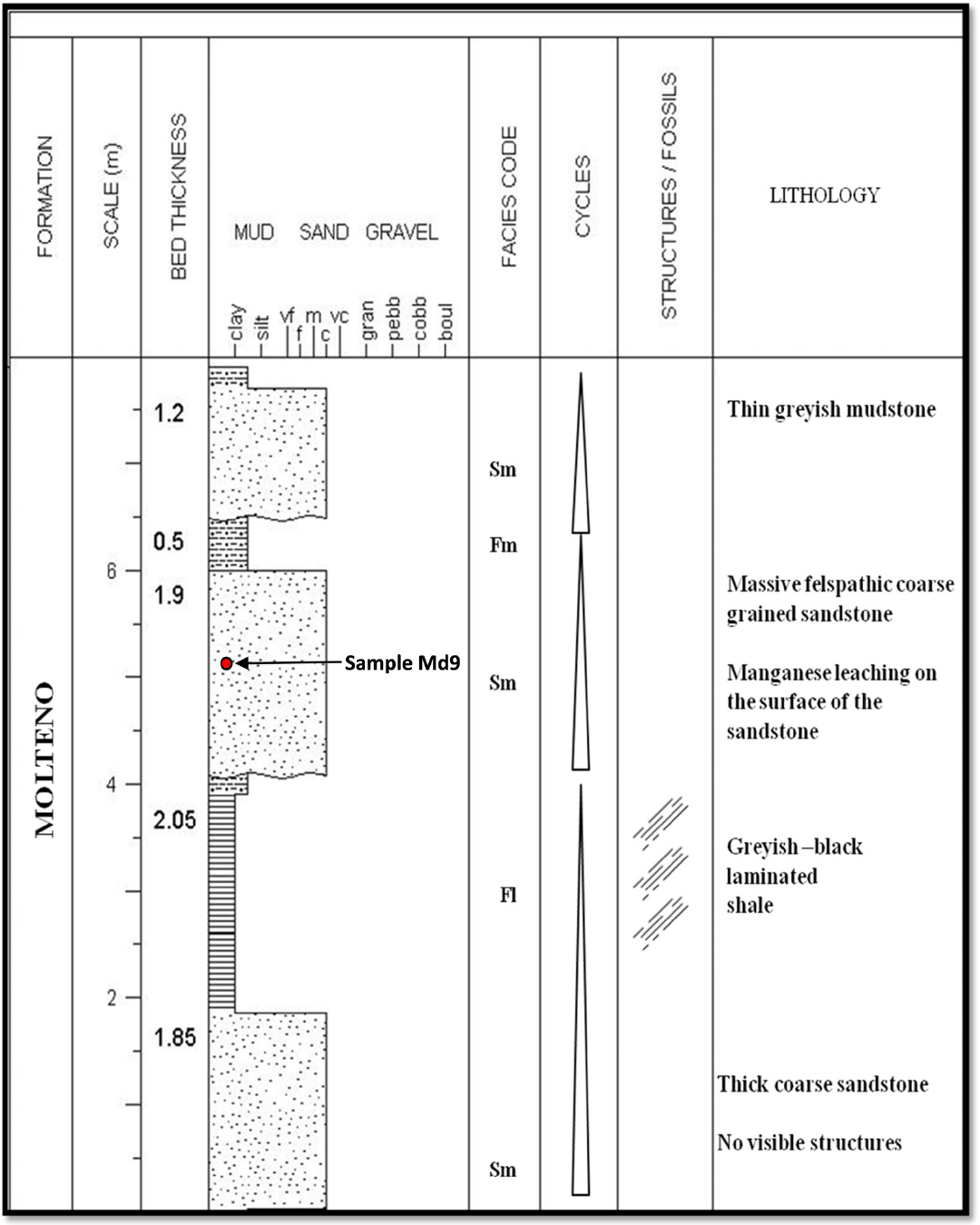 |
Measured stratigraphic profile of the Elliot Formation near Rossouw (Eastern Cape: S 31° 10.950’, E27° 17.636’).
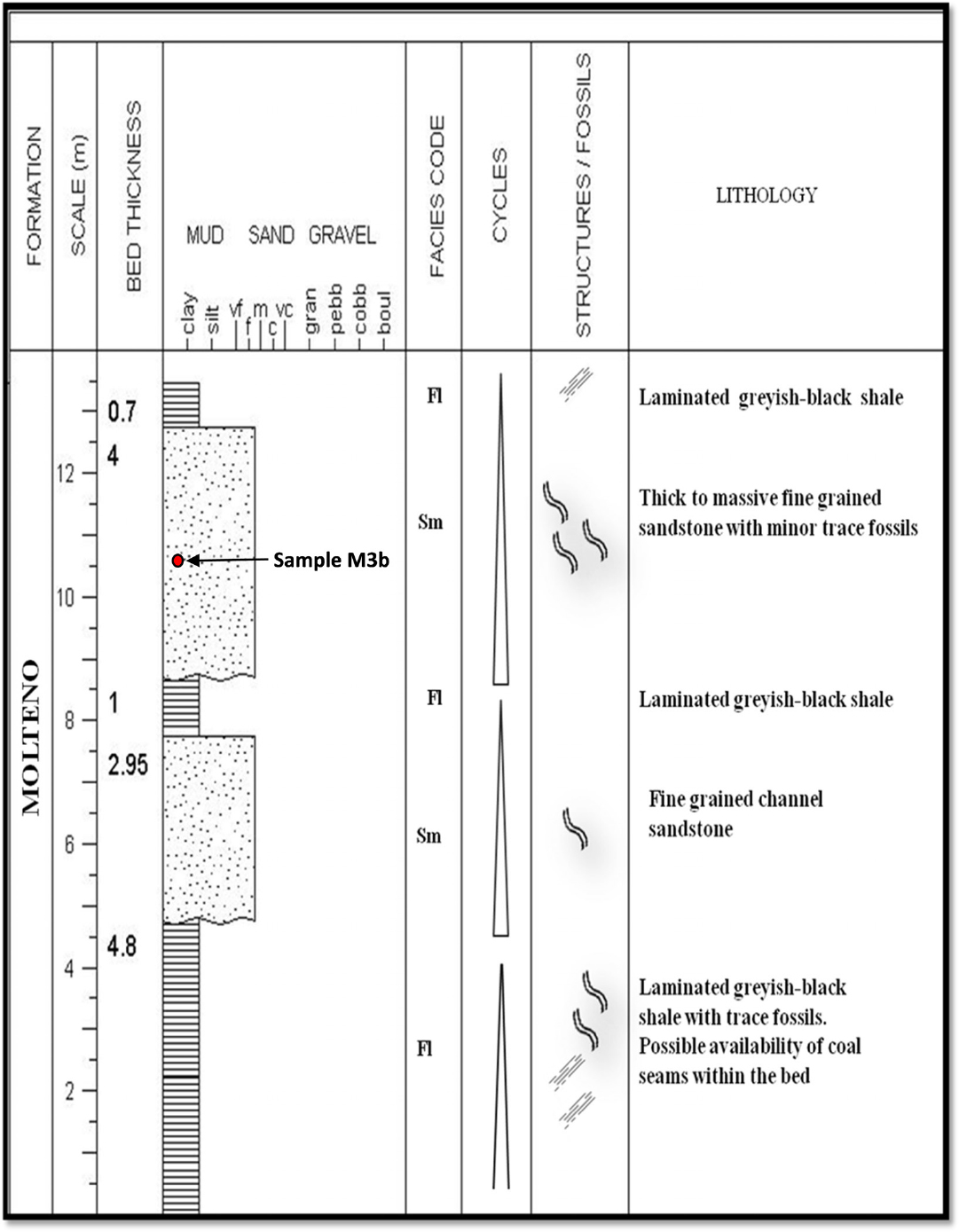 |
Measured stratigraphic profile of the Elliot Formation near Elliot town (Eastern Cape: S 31° 15.202’, E27° 49.579’).
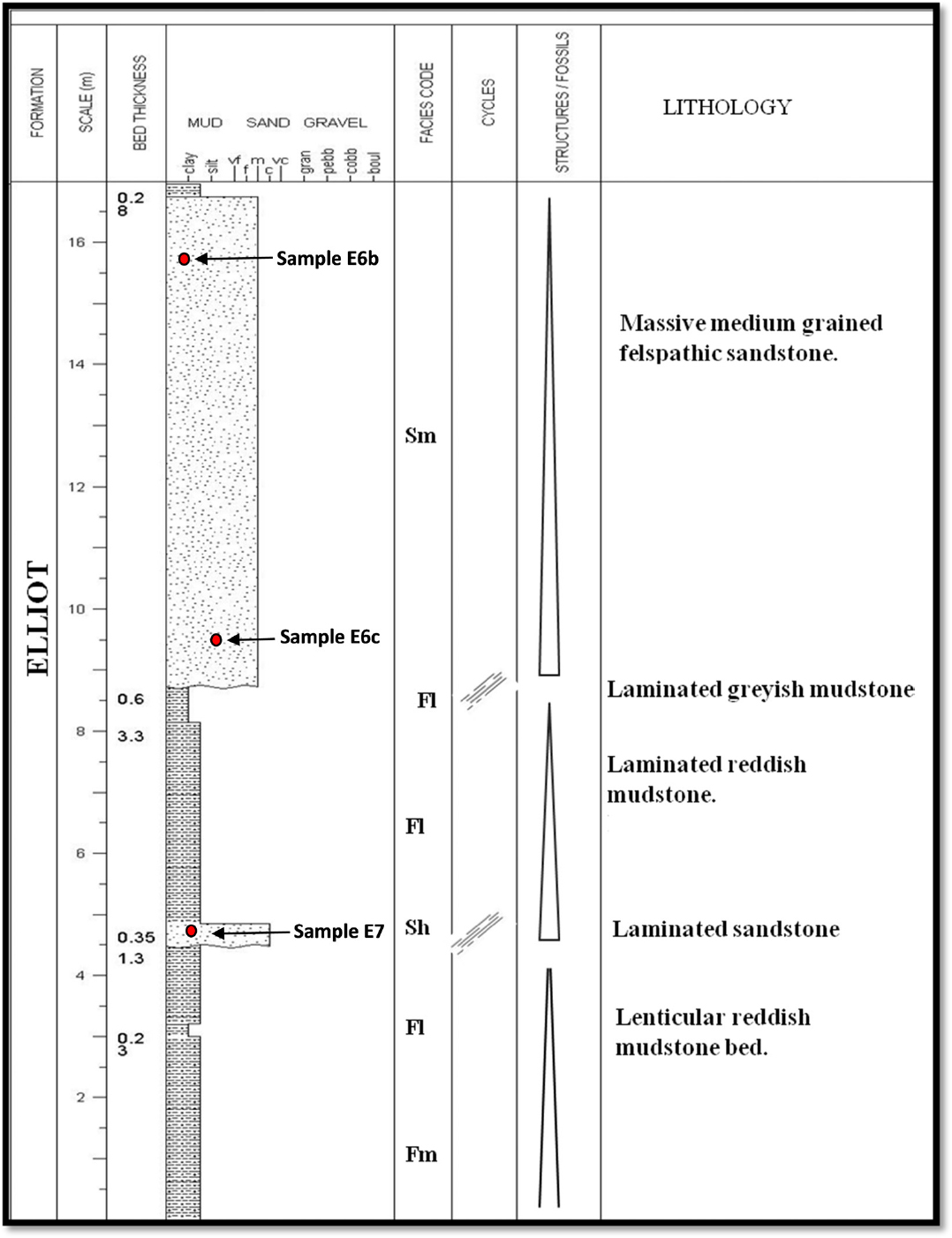 |
Measured stratigraphic profile of the Elliot Formation in Rossouw (Eastern Cape: S 31° 10.950’, E27° 17.636’).
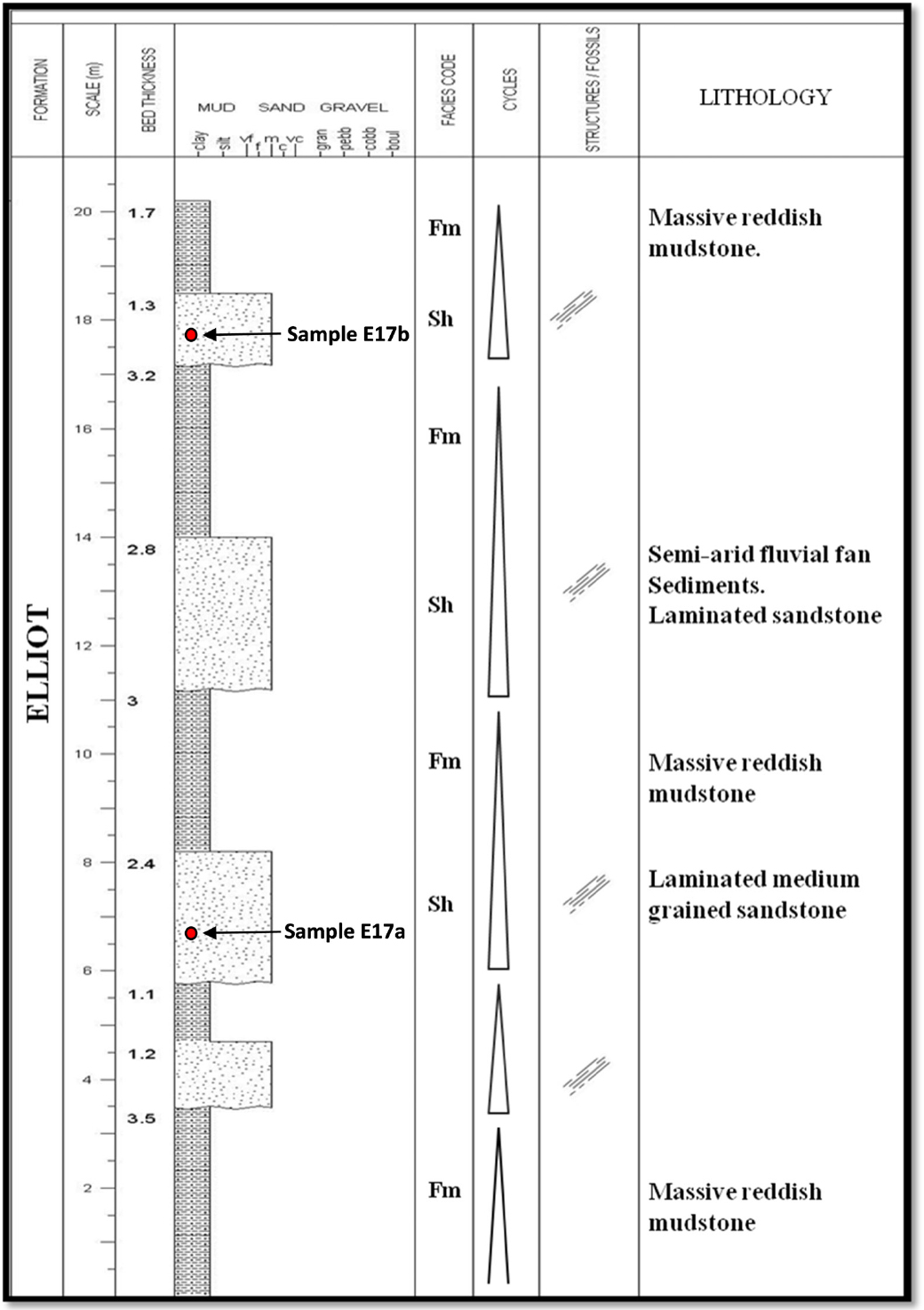 |
Measured stratigraphic profile of the Clarens Formation at Barkly Pass (Eastern Cape: S 31° 10.525’, E27° 46.888’).
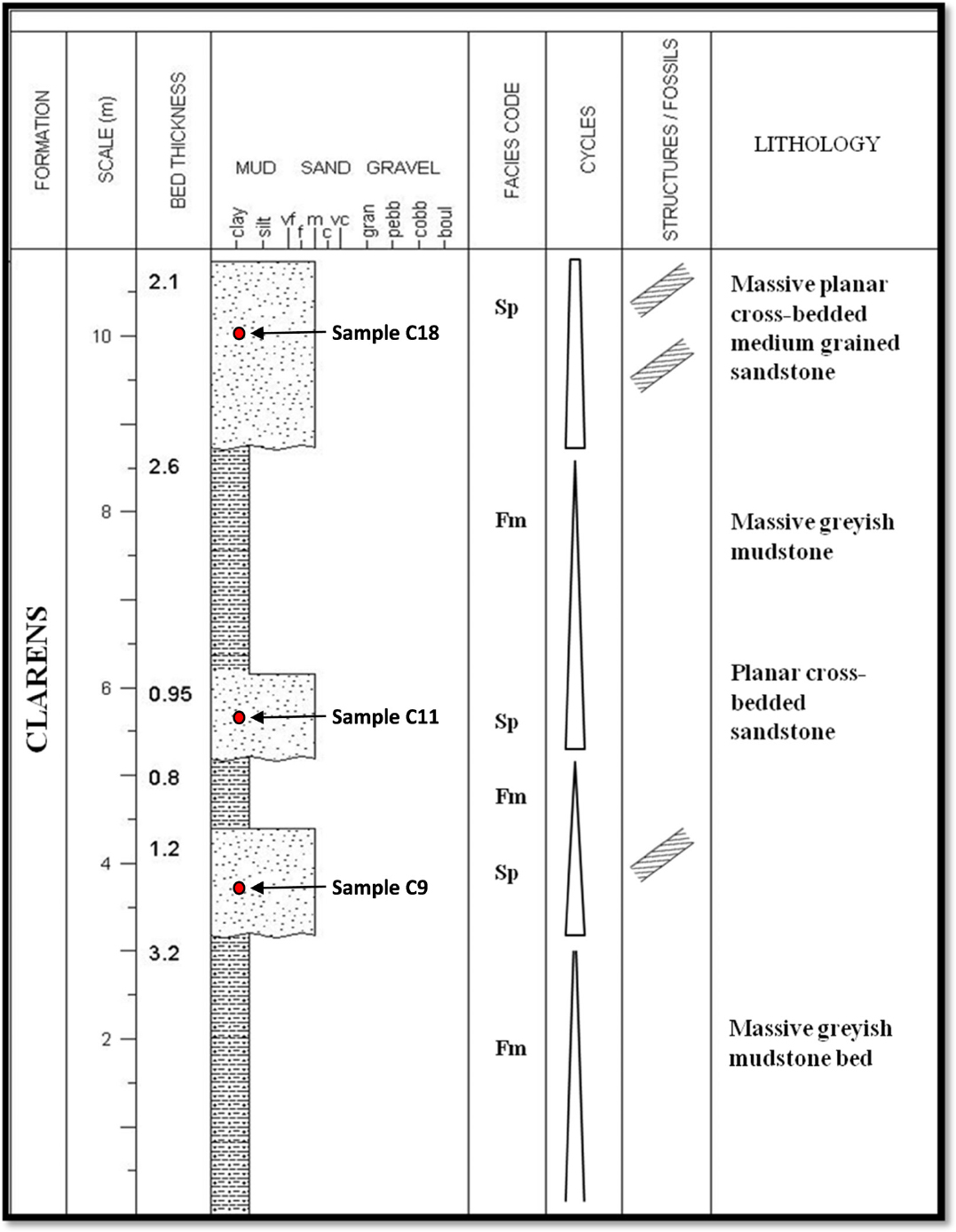 |
Measured stratigraphic profile of the Clarens Formation near Elliot (Eastern Cape; S 31° 13.504’, E27° 50.942’).
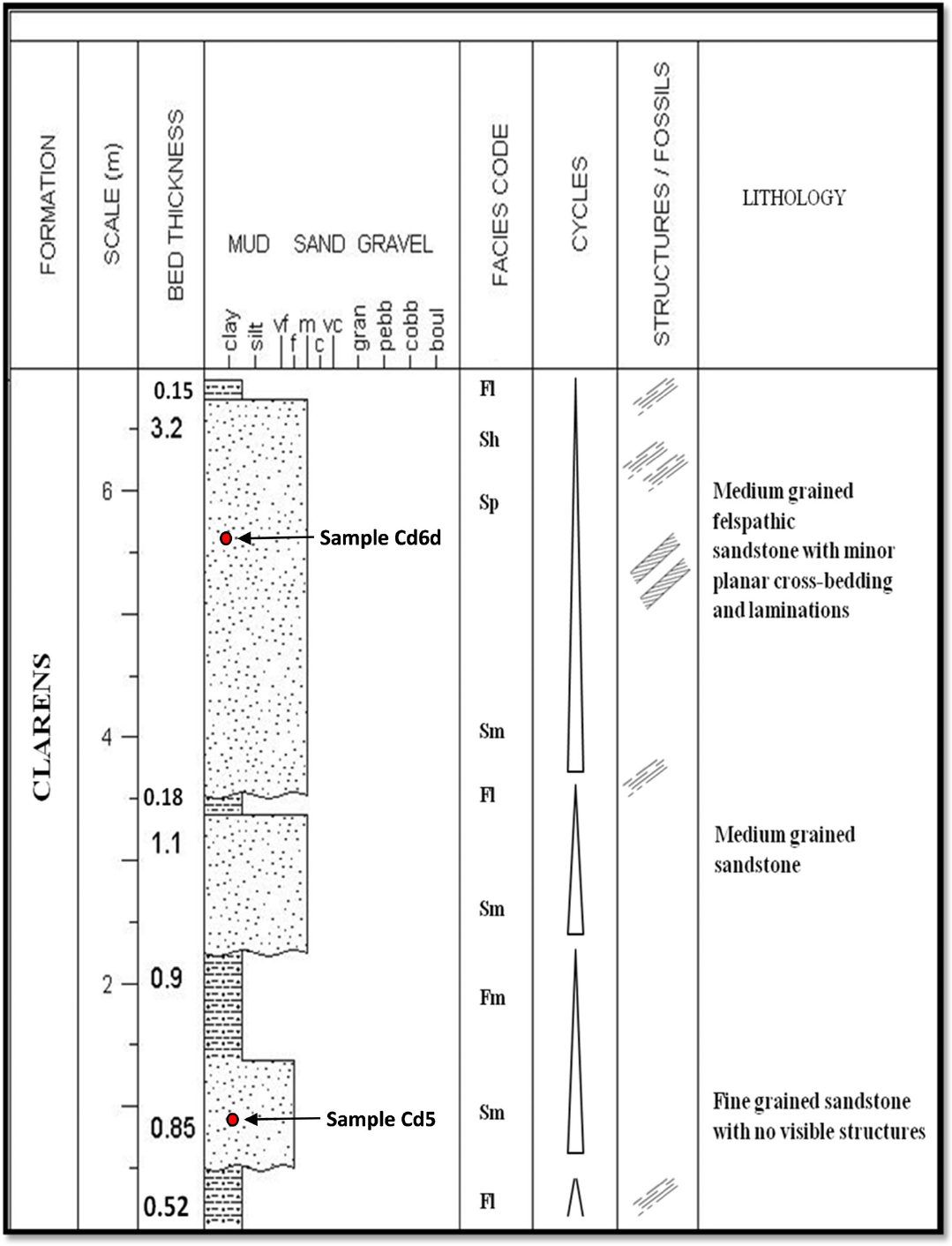 |
4.1.1 Silica/Quartz cementation
Quartz overgrowth is the most common type of silica cement in all the three formations and the Molteno Formation has more silica cement than to the other two formations. The silica cement precipitated around the detrital grains. The pore filling cement formed authigenetically in situ from pore-fluids. The overgrowths (Figure 3) give the quartz grains more euhedral shapes (Figure 4). Silica cementation tends to originate from pore fluids which are enriched in silica and precipitated as overgrowths.
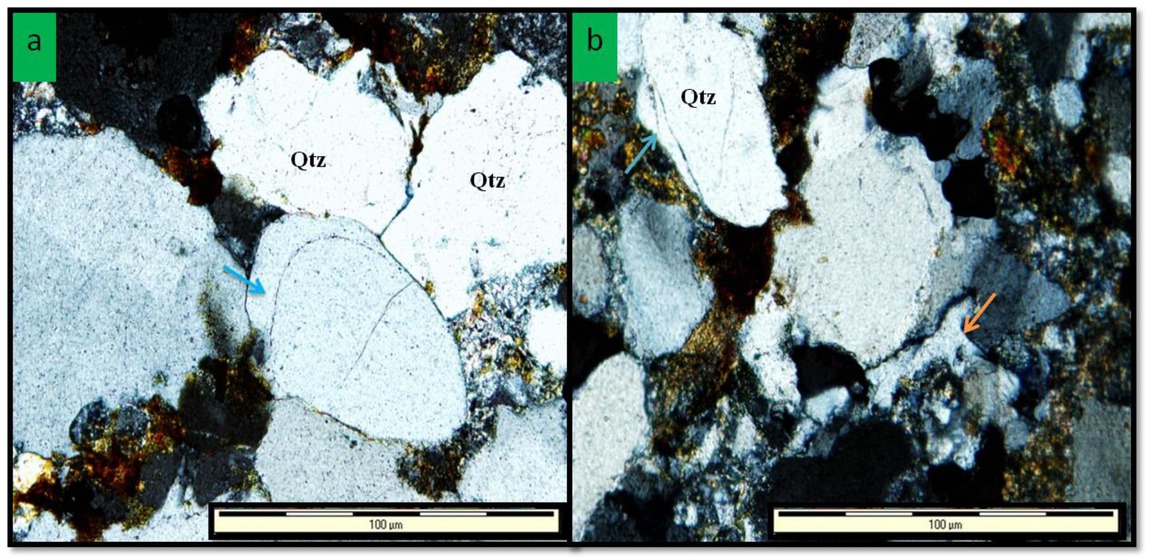
(a) Photomicrograph showing quartz overgrowth (blue arrow) in the sandstone of the Molteno Formaiton (Sample M4). (b) Quartz cement (orange arrow) and quartz overgrowth (blue arrow) in the sandstone of the Clarens Formation (Sample C18).
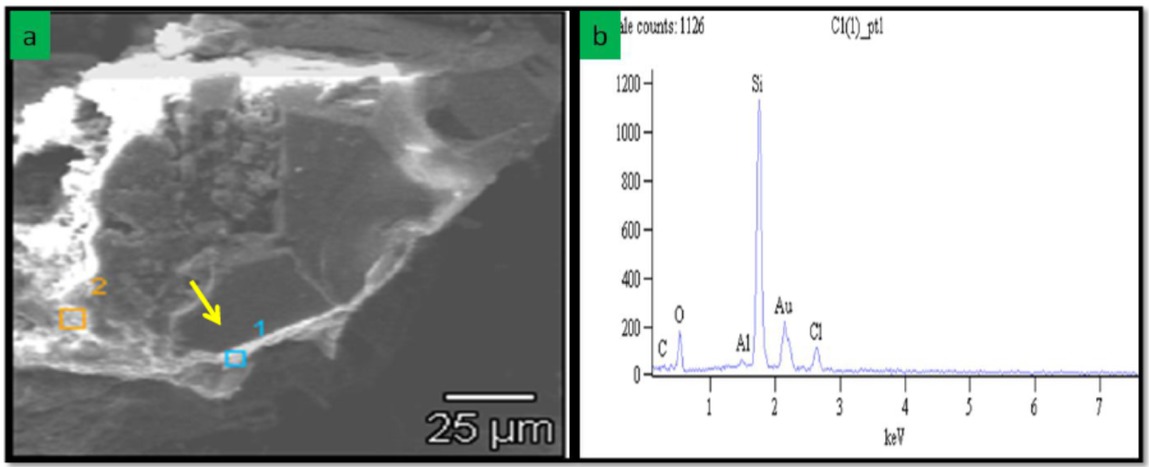
(a) SEM photomicrograph of sandstone sample from the Clarens Formation showing quartz cement (yellow arrow) (Sample C18). (b) EDX graph showing elemental composition of quartz at point 1 (blue area).
4.1.2 Calcite cementation
Calcite cementation is another type of cement in the sandstones of the Molteno, Elliot and Clarens Formations, with the latter formation having the highest content of calcite cement. This cement mostly occurs as a pore-filling and replacement mineral of clay matrix and detrital grains,perhaps, could signify precipitation in different diagenetic stages. The calcite cement tends to corrode the grain margins to produce irregular shaped grains (Figure 5). Most of the clay minerals (i.e. illite and sericite) and detrital grainswere seriously attacked and replaced by calcite (Figure 5). Precipitation of calcite cements tends to suppress later quartz overgrowth formation and/or feldspar alteration and can result in reduction of porosity and permeability.

Thin section photomicrograph of sandstone from the Molteno Formation showing calcite cement (red arrows) (Sample Md9). The calcite also replaced detrital framework grains (far left arrow - the zigzag boundary is a sign of replacement).
4.1.3 Feldspar cementation
Feldspar cement is not a common cement types in the sandstones. This cement exists as pore-filling and as overgrowths around detrital K-feldspar grains (Figure 6). Feldspar overgrowths act as authigenic feldspar pore-filling cement and possibly indicate early diagenetic mineral. Occasionally, the feldspar overgrowth has hematite around the original detrital grain. Much of the feldspars grains are mostly replaced by sericite or illite.
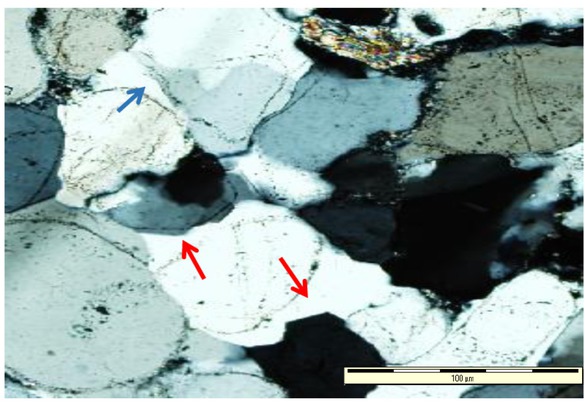
Thin section photomicrograph of sandstone depicting feldspar overgrowths (red arrows) and feldspar cement (blue arrow) (Sample Md9).
4.1.4 Hematite cementation
Hematite cement is not as common as other types of cement in the sandstones. The cement precipitates directly in the intergranular pore space or line on the grain surfaces, visible as reddish-brown rims on grain surfaces (Figure 7). Most of the clay minerals and detrital grains have been stained by iron oxide, thus they show reddish stain colour.
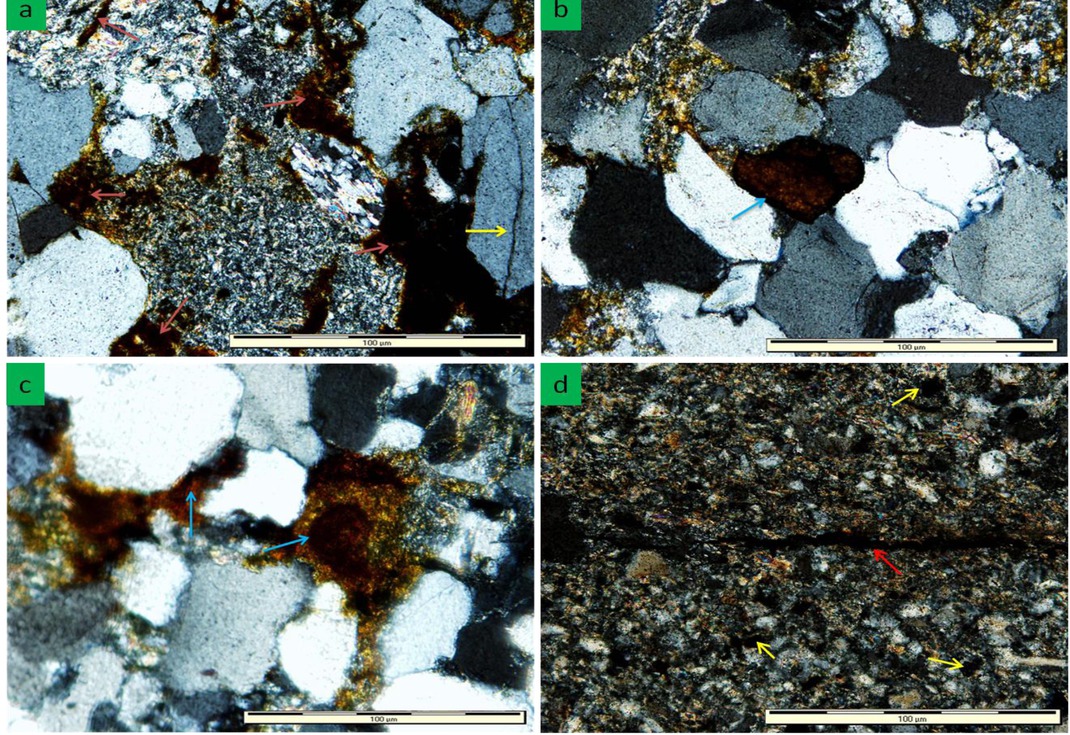
Thin section photomicrographs showing: (a) Hematite cement (brown arrow) and grain crack (yellow arrow) from sandstone of the Molteno Formation (Sample M14a). (b) Hematite pellet in sandstone of the Elliot Formation (Sample E7). (c) Hematite cement (left blue arrow) and pellet (right arrow) in sandstone of the Clarens Formation (Sample C9). (d) Siltstone with hematite pellets (dark points-yellow arrows) and also fills secondary stylolite fracture (red arrow) (Sample C9).
4.1.5 Clay mineral cementation
Clay minerals are the most common cementing materials in the sandstones of the Molteno, Elliot and Clarens Formations. These minerals behave as pore lining and pore-filling cements. Smectite, kaolinite, chlorite and illite are the most common authigenic clays in the sandstones. These clay minerals are sometime formed due to recrystallization of fine matrix and dissolution of K-feldspars. Furthermore, they may also have been formed as a result of modification or alteration of one kind of clay mineral to another, for instance, both smectite and kaolinite were transformed into illite. Smectite recrystallized into illite and chlorite, kaolinite recrystallized into illite. Illite also further changed to sericite, which later recrystallized to muscovite.
(1) Kaolinite clay
Kaolinite cement mostly occurred as pore filling and lining clay mineral and sometimes as a replacement mineral. The pore filling aggregates which appears as booklet vermicules (Figure 8). Altered K-feldspars are a source of silicon and aluminium to form kaolinite [35] and not exclusive to early diagenesis. The low percentage of kaolinite in the samples (Table 9) implies that pore waters may have been depleted in silicon and aluminium ions and/or due to transformation into chlorite in the late diagenetic stage.

(a) SEM photomicrograph showing accordion or book-like kaolinite (Sample M14a). (b) EDX graph showing elemental composition of kaolinite at point 1 (ref area) (Sample M4).
X-ray diffraction percentage mineralogical abundances (%) in the sandstones of the Molteno, Elliot and Clarens Formations.
| Formation | Sample label | Sample location | Quartz | Plagioclase | K-Feldspar | Mica | Calcite | Kaolinite/Chlorite | Laumontite | Smectite | Rutile | Garnet | Zircon | I/S Interstratification |
|---|---|---|---|---|---|---|---|---|---|---|---|---|---|---|
| Clarens | C9 | Barkly Pass (S 31° 10.525', E27° 46.888') | 76 | 15 | 5 | 3 | - | - | - | - | - | tc | tc | - |
| C11 | Barkly Pass (S 31° 10.525', E27° 46.888') | 76 | 13 | 5 | 2 | - | - | 4 | - | - | tc | - | - | |
| C18 | Barkly Pass (S 31° 13.504', E27° 50.942') | 91 | 5 | - | 3 | - | - | - | 2 | tc | tc | tc | - | |
| Cd5 | Near Elliot town | 74 | 14 | 8 | 2 | - | - | 1 | - | tc | tc | - | - | |
| Cd6b | Near Elliot town | 62 | 7 | 4 | 1 | - | - | 24 | 2 | tc | - | tc | - | |
| Elliot | E6b | Elliot town (S 31° 15.202', E27° 49.579') | 74 | 10 | - | 12 | - | 4 | - | - | tc | - | tc | - |
| E6c | Elliot town (S 31° 14.411', E27° 49.277') | 88 | 5 | - | 6 | - | 6 | - | - | - | tc | tc | - | |
| E7 | Elliot town (S 31° 10.950', E27° 17.636') | 72 | 17 | - | 11 | - | - | - | - | tc | tc | - | - | |
| E17a | Rossouw (S 31° 10.950', E27° 17.636') | 75 | 16 | 4 | 1 | - | - | - | - | - | - | tc | 5 | |
| E17b | Rossouw (S 31° 13.539', E27° 17.232') | 82 | 12 | - | 6 | - | - | - | - | tc | tc | tc | - | |
| Molteno | M3b | Rossouw (S 31° 10.950', E27° 17.636') | 90 | - | - | 7 | - | 3 | - | - | tc | tc | - | - |
| M4 | lndwe(S 31° 27.196', E27° 22.338') | 73 | 10 | - | 7 | 1 | 8 | - | - | tc | - | - | - | |
| Md9 | Near Cala (S 31° 36.928', E27° 27.932') | 75 | 11 | - | 9 | 2 | 3 | - | - | tc | tc | tc | - | |
| M14a | lndwe(S 31° 36.548', E27° 30.974') | 71 | 8 | - | 9 | 3 | - | - | - | tc | - | 8 | ||
| M14b | lndwe(S 31° 36.548', E27° 30.974') | 75 | 11 | - | 5 | 5 | - | - | tc | tc | tc | 6 |
Note: tc: trace, - : not detected, BE: Barkly East, NE; Near Elliot, ET: Elliot town, RO: Rossouw, NC: Near Cala, and ID: Indwe.
(2) Smectite clay
SEM examinations revealed that smectite clay occurred in small fractions in the form of thin fibres/flakes coating detrital grains (Figure 9). Furthermore, the smectite occurred as infiltrated clays, authigenic cement as well as mud intraclasts. In some cases, illite grows from the surface of the cornflake-shaped smectite or forms the mixed illite-smectite interlayers. It tends to have high aluminium/silicon content and thus it is a potential source for quartz cementation when it is dissolved or altered.

(a) SEM photomicrograph showing cornflake-shaped smectite (Sample C18). (b) EDX graph showing elemental composition of smectite at point 1 (red area).
(3) Illite clay
Illite clay occurs as pore filling and lining clay minerals. It also occur as booklets and vermicular stacked platelets that resemble kaolinite (Figure 10a). SEM examinations revealed the transformation of smectite to illite (Figure 10a) through the process of illitization. Illitization usually occur after the precipitation of kaolinite and smectite and requires influx of potassium under a higher temperature [2, 36]. Illite commonly retains the shape of its predecessors especially when it is formed due to dissolution of kaolinite [2]. The formation of illite requires a growth medium (pore fluid and space) with high potassium, silica and aluminium compositions. The EDX spectral line (Figure 10b) shows that the mineral is mainly composed of silica and aluminium, whereas potassium, iron and magnesium elements only occur in small quantity.
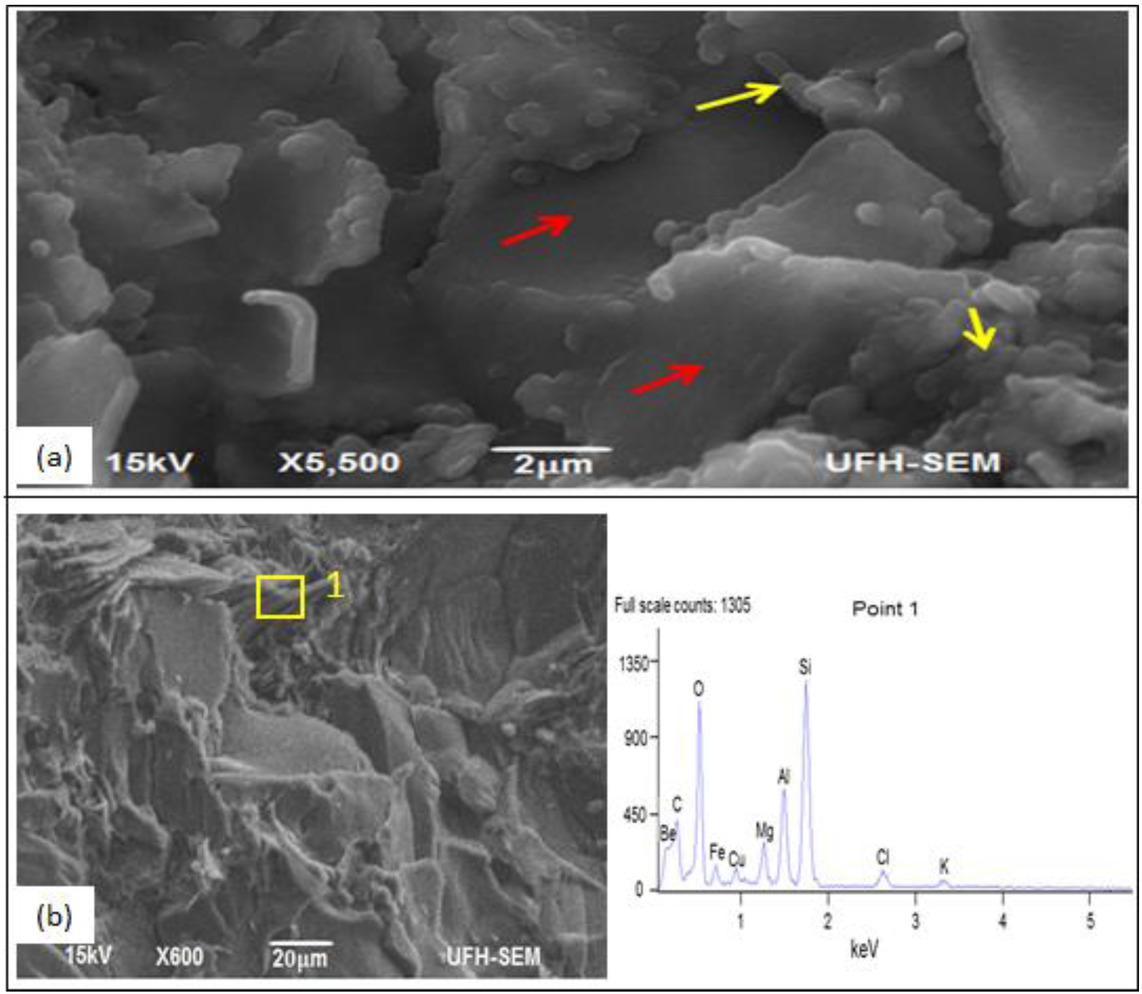
(a) SEM photomicrograph showing illite growth (yellow arrows) on smectite flakes (red arrows) (Sample M3b). (b) SEM photomicrograph showing fabric shaped illite (yellow arrow) and EDX graph showing elemental composition of illite at point 1 (yellow area) (Sample M3b).
5 Discussion
5.1 Styles in grain compaction
Rock texture is revealed by the geometrical relationships of the grains and matrix [37]. The degree of compaction varies considerably, ranging from nearly non-compacted to moderately and to strongly compacted sediments [38]. As compaction continues, the ductile grains became squeezed between quartz clasts, forming a dispersed pseudo-matrix. The amount of plastic deformation and framework collapse is dependent upon the amount of lithic fragments and on the time of introduction and quantity of cementation [39]. The grain contact patterns gradually change from non-contact (floating packing) to point contacts to long contact, then to concavo-convex contact and finally to sutured contact ([40]; Figure 11). In the case of more rigid grains, the mechanical compaction caused floating and point contacts to become long contacts and fracturing of rigid framework components. This strain is attributed to some of quartz grains developing undulose extinction and even semi-composite undulose extinction. Chemical compaction resulted in the formation of dissolutional contacts which give concavo-convex and sutured grain contacts, both caused by pressure solutioning.
![Figure 11 The variables of grain to grain contact patterns due to increased burial depth (Redrawn from [40]).](/document/doi/10.1515/geo-2018-0059/asset/graphic/j_geo-2018-0059_fig_011.jpg)
The variables of grain to grain contact patterns due to increased burial depth (Redrawn from [40]).
The Molteno, Elliot and Clarens Formation sandstones displayed grain contact patterns which range from point to sutured contacts as a result of progressive burial (Figure 12). The grain-to-grain contacts are mainly parallel to
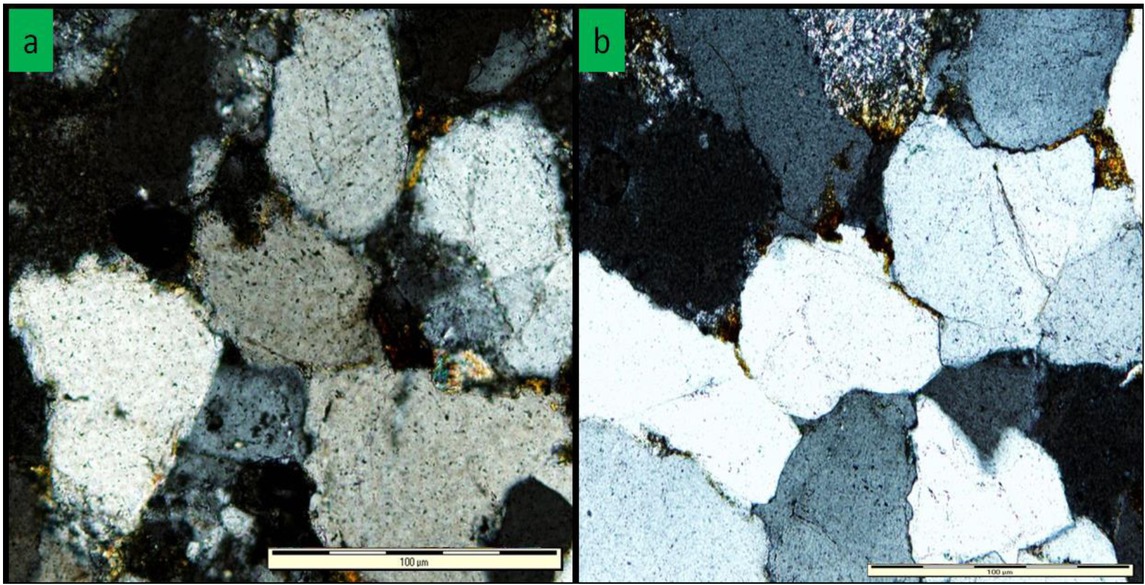
Photomicrograph of sandstone showing (a) point, long contacts between detrital grains (Sample Cd5), (b) concave-convex and sutured grain contacts between grains (Sample Cd5).
the long-axis of the individual grains suggesting that the grains were mechanically compacted. In sandstones, long-axis grain contacts are mostly representative of intermediate burial depth and concave-convex and sutured contacts are as a result of intense compaction and pressure dissolution processes during deep burial diagenesis.
5.2 Grain deformation and fracturing
Grain fracturing, though not intense, was observed on some detrital quartz grains in samples from Molteno Formation (Figure 13). Some muscovite grains also have been deformed due to pressure dissolution. Optical microscope observations of thin sections also show that these sandstones have undergone chemical compaction which involves dissolution, recrystallization and precipitation because points of contact between grains are susceptible to dissolution which is an apparent response to overburden weight and higher stress [41]. There are various factors that affect the rock mechanical properties, including the component grains, textures, structures, porosity, permeability and pore fluids of the rocks [40]. Grain fracturing provides key evidence of the processes of compaction, consolidation, and the patterns of fluid flow. Grain fracturing takes place mostly during late diagenesis and is influenced by processes such as dissolution, which tends to enlarge the fractures. As compaction, tectonic compression and other diagenetic processes continue to occur, the mineral particles turn from a point contact to a lineal grain contact. In this process, micro fractures such as grain boundary and intragrain fractures develop (Figure 14).
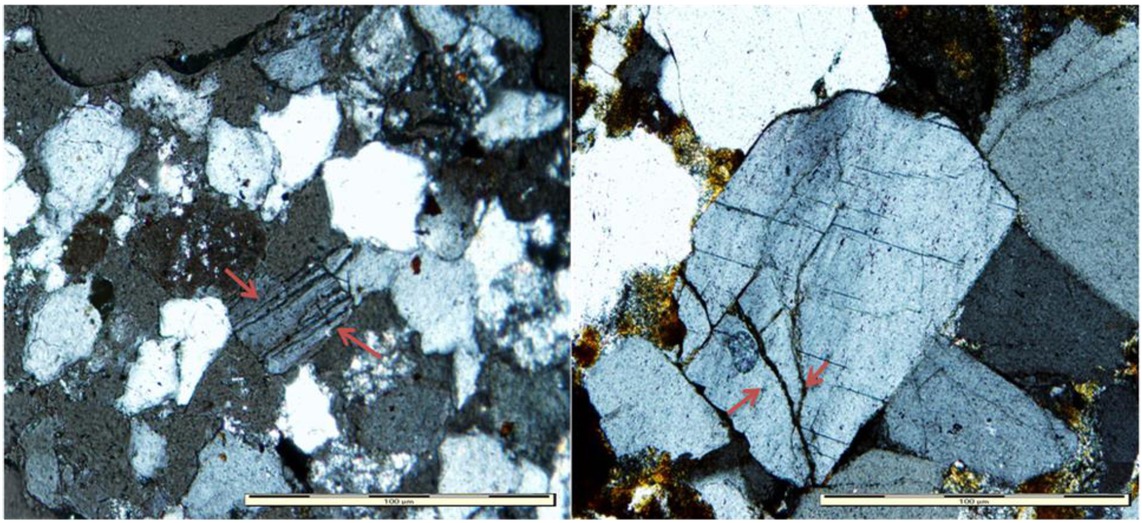
Photomicrograph of fractured grains (brown arrows) due to increased burial pressure during deep burial diagenesis (Sample Md9).
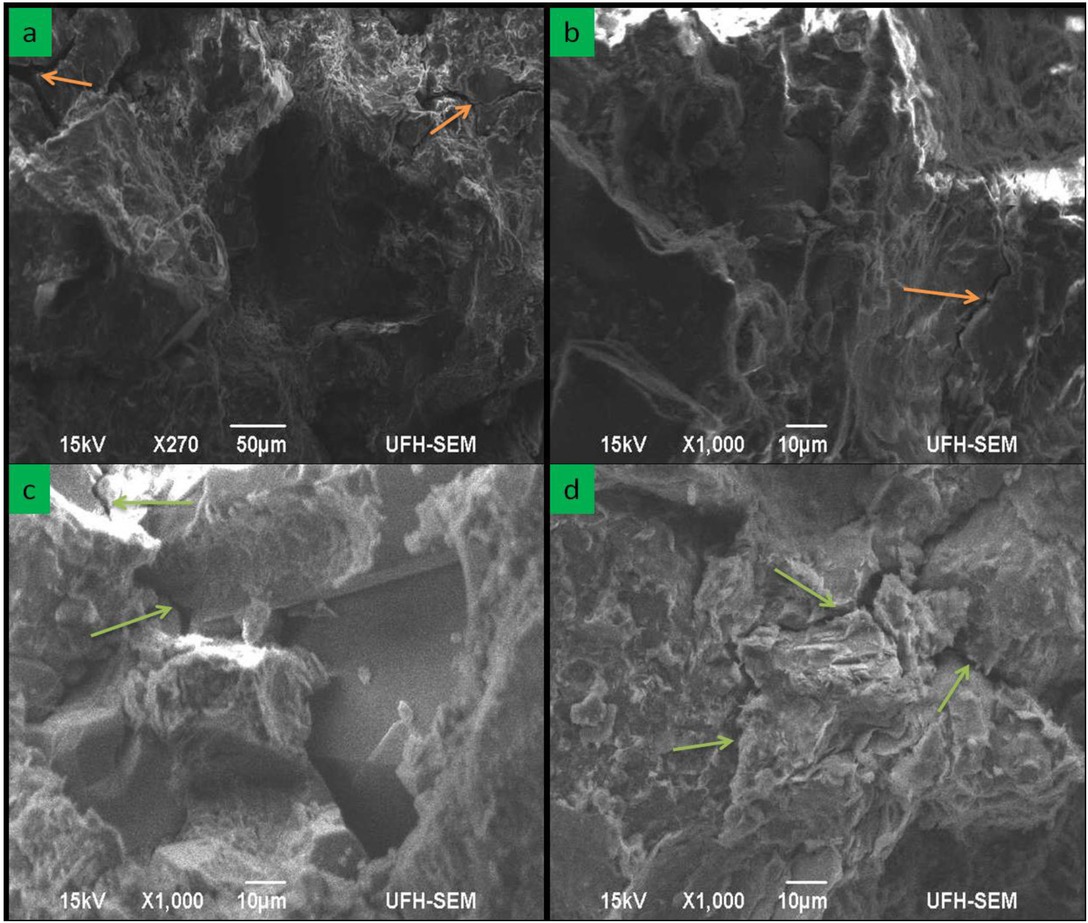
SEM images of micro-pores and cracks. (a) Some of the pores occur as intergranular pore and others occur due to grain-shelter (Sample C18). (b) Secondary cracks (pores) parallel to lamination (middle parts of the image) and also intra-grain cracks (orange arrow) (Sample C18). (c) Intracrystalline pores (arrow) occur between recrystallised mineral graines (Sample C11). (d) Secondary cracks/fractures were formed due to burial compaction, which can improve porosity and permeability of reservoir rocks (Sample C11). Images a, b, a and d are from Clarens Formation.
5.3 Dissolution
As documented by [40], dissolution mostly involves the removal in solution of all or part of previously existing minerals, leaving pore spaces in the rocks. Dissolution creates crack and sometimes form sutured grain contacts due to pressure solution along grain boundaries (Figure 15). Also, it tends to facilitate the silica source for quartz cement and overgrowths and sometime creates a brownish iron rim or
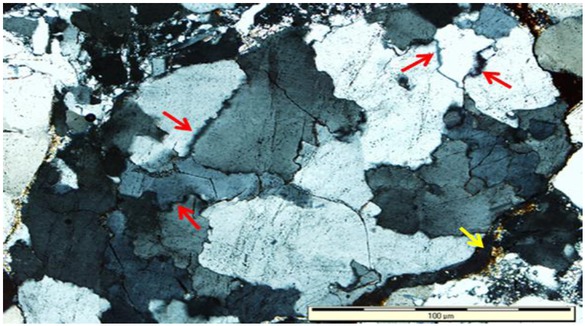
Thin section photomicrograph showing dissolution crack (yellow arrow) and sutured grain contacts formed by pressure solution along grain boundaries (red arrows) (Sample Cd6d).
dust seam around the grain. Quartz overgrowths in sandstones without pressure solution effects may reflect significant upward migration of silica rich solutions from more distant sites of pressure solution or rather indicate other silica sources [42]. SEM observation revealed that some kaolinite and albite grains were formed due to dissolution of weak detrital K-feldspars, which also releases silica, thus providing silica source for the formation of authigenic quartz. The dissolution and replacement of feldspar to illite also favoured the formation of authigenic quartz. Secondary porosity may have been created by the dissolution of the authigenic minerals or sedimentary grains. During compaction, dissolution processes contribute to the alteration of smectite to illite under deep burial when fluids are removed from the intergranular spaces [43]. Dissolution processes were most prevalent in the samples from the Molteno and Elliot Formations which are dominated by major quartz overgrowths.
5.4 Mineral replacement
Replacement occurs when pore fluids are not in equilibrium with the fragments within the rock, thus promoting solution-precipitation reactions [1]. During this process, texture and composition of rocks are altered and further migration of fluids tends to promote cementation. In terms of porosity, replacement processes tend to promote secondary porosity. Petrographic study of the samples collected from the three shows that formations, authigenic minerals tend to replace some cements and grains. Replacement of quartz, feldspars and clay matrix by calcite (Figure 16) is a common replacement process in the studied sandstones.

(a) Photomicrograph of sandstone from the Elliot Formation showing calcitization (blue arrows) of clay minerals (Sample E17b). (b) Photomicrograph showing calcite replacement of clay matrix (red arrow) and detrital grains (yellow arrows) (Sample E6b).
5.5 Recrystallization
Mineral recrystallization is a common phenomenon in the sandstones from all the three formations. Smectite gradually changes to illite, then to sericite and finally muscovite (Figure 20). Illite clay also occurs as booklets and vermicular stacked platelets that resemble kaolinite (Figure 10a). This possibly indicates that they were formed as a result of partial to complete alteration or recrystallization of kaolinite and smectite [44]. Detrital grains such as quartz and feldspar also undergo vast recrystallization through the increase of crystalline size as overgrowths (Figure 21). Progressive recrystallization tends to increase grain size while reducing the pore space between the grains thus negatively affecting both porosity and permeability.
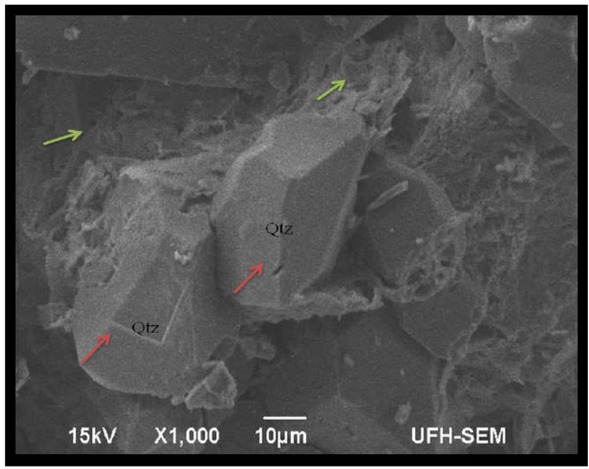
SEM image showing euhedral crystalline authigenic quartz (Qtz) and clay cements (green arrow) (Sample E17b).
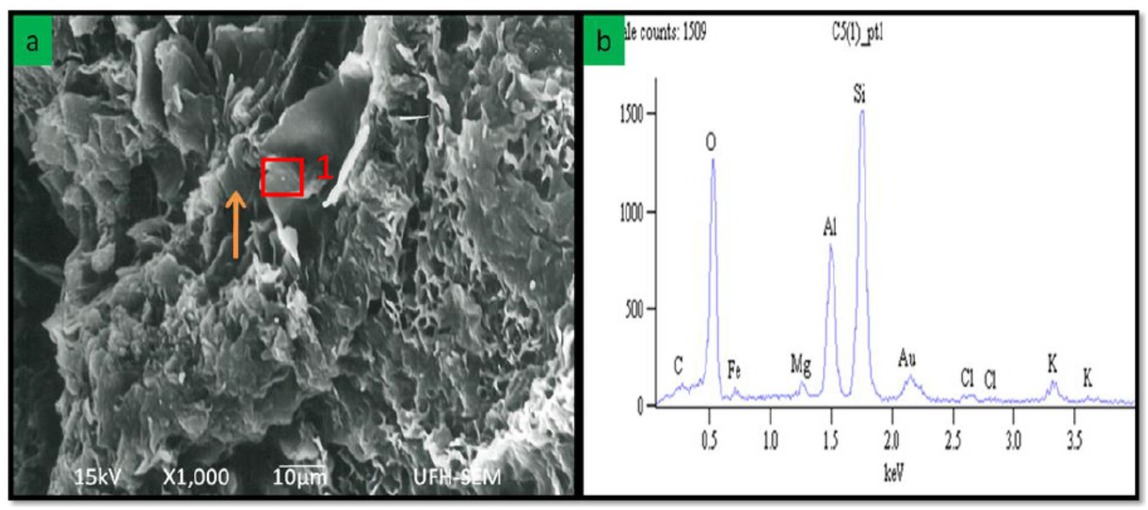
SEM image of sandstone from the Molteno Formation showing (a) Rosette shaped authigenic chlorite growing in previous pore area (orange arrow) (Saple E6c). (b) EDX graph showing elemental composition of authigenic chlorite at point 1 (red area).
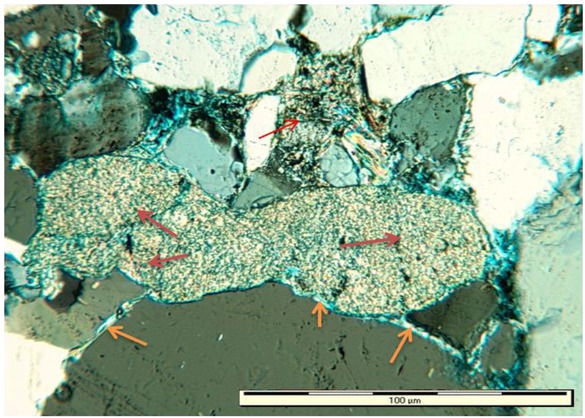
Photomicrograph showing authigenic clay minerals. Pore filling (red arrow), Pore lining (orange arrow) and Pseudo clay matrix (brown arrows) (Sample E6c).

(a) Photomicrograph showing intense sericitisation (blue arrow) and hematite cementation (orange arrow) (Sample C18). (b) Recrystallization of clay minerals into muscovite (blue arrow) (muscovitization) and sericite (yellow crystals, orange arrow) (Sample E7). (c) Recrystallized clays being replaced by sericite (sericitisation) (Sample M4). (d) Detrital muscovite (red arrow) and hematite cement replacing clay matrix (blue arrow) (Sample M4).
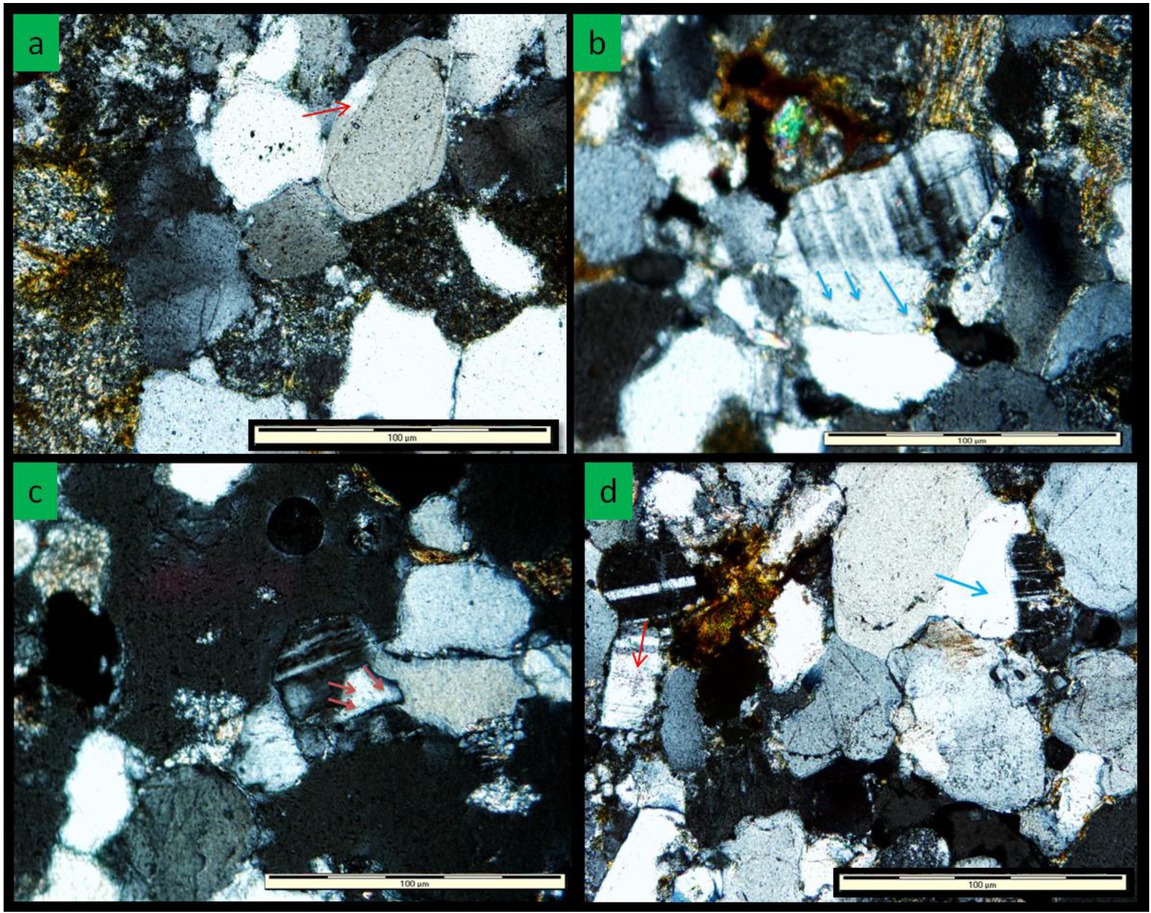
(a) Photomicrograph of recrystallized quartz in the form of overgrowths (red arrow) (Sample E17a). (b) Feldspar overgrowth which is partially albitized (blue arrow) (Sample C9). (c) Feldspar overgrowth (brown arrow) in sandstone from Molteno Formation (Sample M3b). (d) Quartz overgrowth (blue arrow) and feldspar overgrowth (red arrow) (Sample M3b).
5.6 Nature and occurrence of authigenic minerals
Common authigenic minerals which occur in the studied sandstones include quartz, feldspar, chlorite and clay minerals such as kaolinite and smectite.
5.6.1 Authigenic quartz
Most of the studied samples are found to have secondary growths on the detrital quartz grains (Figure 17). The grain enlargement occurs in optical continuity with the detrital core. SEM observations of the sandstones show that most of the secondary quartz grew in pore spaces with some replacing clay matrix. The more the quartz overgrowths fill the pore spaces, the more the rocks grew to have an interlocking texture forming euhedral crystalline authigenic quartz. In general, the authigenic quartz has significantly reduce the size of intergranular pores and pore-spaces, leading to a significant reduction of porosity and permeability of the sandstones.
5.6.2 Authigenic feldspar
Authigenic feldspar commonly occurs as rims around detrital microcline or orthoclase. In some samples the feldspars replaced the clastic calcite cement forming euhedral rims. However, the feldspar overgrowths tend to have their growth impeded due to the enlargement of nearby quartz grains. Albitization indicates dominance of sodium within formation waters during the burial diagenesis stage [45].
5.6.3 Authigenic chlorite
Chlorite cement is one of the common authigenic minerals present in the samples. SEM image shows that the chlorite crystals have euhedral and sub-euhedral shapes and are arranged in rosette pattern (Figure 18a). The crystals are arranged perpendicular to the detrital grains thus they tend to face the pore spaces. It is possible that the chlorites were formed in the late stage of the diagenetic process under intense temperature and pressure. Elements such as silicon, aluminium and potassium were released from dissolved detrital grains to form some potassium and aluminium salts. Some of the magnesium could have been supplied from the breakdown of ferromagnesian minerals into pore waters [1]. Chlorite is a common cement in channel sandstones and the Fe released as can be observed from EDX analysis (Figure 18b) resulted in the formation of iron-chlorite in reducing environments [46].
5.6.4 Authigenic clay minerals
Clay minerals in sandstones commonly result from the alteration of feldspars. Smectite and kaolinite occurs in the samples as pore filling and pore lining authigenic clay minerals (Figure 19). The dissolution of the feldspars results in secondary porosity and the authigenic clay minerals form cement between the grains. Grain-coating clays are one of the earliest authigenic minerals common in fluvial, playa and lacustrine sandstone facies. Most of the clay minerals and detrital grains in the sandstones of the Elliot Formation have reddish colour stain. Clastic sediments acquire the reddish colouration from hematite which is more common in continental depositional environments such as deserts, floodplains and alluvial fans [47]. The iron could have resulted from the weathering of iron bearing minerals such as laterite in upland areas, transported and deposited along with the sediments, which are later converted to hematite under favourable moist tropical/subtropical climate conditions. This iron oxide in the form of reddish-brown cement occurs as pore-filling cement, thin coatings around detrital grains and within mica flakes and along cracks boundary (Figure 7). This suggests that the formation of these grain coatings occurred in the early diagenetic stage under the presence of oxygen. [47] argued that the maroon colouration of the Elliot Formation was not direct evidence of deposition in a desert environment, but was rather the result of in situ diagenetic alteration of iron-bearing minerals. Iron was released during the breakdown of unstable ferromanganese or iron oxide minerals in the sandstones under surface temperature and pressure conditions.
5.7 Diagenetic stages
The aforementioned diagenetic processes in the sandstones of the Molteno, Elliot and Clarens Formations can be grouped into early diagenesis, late diagenesis and uplift-related diagenesis.
5.7.1 Early diagenesis
Time–temperature history, primary mineralogy and fabric and geochemistry of the pore water are the main factors that affect early diagenesis [1]. The processes in the early diagenetic stage include organic reworking (bioturbation), cementation (i.e. quartz and feldspar cementation, and clay-mineral authigenesis) and consolidation. These diagenetic processes often results in the destruction of primary and/or depositional porosity. The depositional environment influences the formation of sulphides in reducing environments, and iron oxides in oxidizing environments [48]. Also, the process of cementation initialises through the precipitation of clay matrix (cements), quartz and feldspar cements and overgrowths and authigenic clay minerals (Figures 3, 9 and 19). The cementation tends to cause moderate lithification to the sediments. Cements such as calcite, smectite, kaolinite, quartz and feldspar cements occurred after the clay matrix, while authigenic minerals, illitization/sericitisation and compaction continue even to early stages of late diagenesis [1]. Hematite cement was precipitated after most of the clay cements, especially in the sandstones of the Molteno and Elliot Formations. Abundance of iron oxide-rich pore waters influenced much of the quartz and feldspar grain coating with reddish-brown hematite rims due to dissolution and relic precipitation.
5.7.2 Late diagenesis
The main factors that affect late diagenesis are increased temperature, pressure and change in pore-water compositions [40]. These factors led to physical and chemical or mineralogical changes so as to get the sediments into equilibrium with the diagenetic environment [2]. Late diagenesis in the Molteno, Elliot and Clarens Formations began with the compaction of sediments as a result of increase in overburden pressure. This led to more tightness of grain packing and partial loss of pore spaces. Thereafter, authigenic quartz and feldspars develop some overgrowths and there is also partial to complete replacement of silica minerals and clay matrix by new minerals (smectite, illite, sericite, kaolinite) thus impacting negatively on porosity (Figures 20 and 21). Clay mineral authigenesis led to the alteration of one clay mineral to the other (i.e. smectite recrystallized into illite and sericite or chlorite and kaolinite recrystallized into illite, while illite changed to sericite) [2]. In addition, muscovitization and albitization (Ca-plagioclase and K-feldspar is changed to albite) also occurred. Albitization of feldspar probably occurred during fracturing of the detrital K-feldspar grains. Towards the end of the late diagenetic stage, as a result of compaction, the grain contact patterns change from point to planar contact to concave-convex contact and finally to sutured contacts. Furthermore, muscovite flakes became slightly bent and deformed due to over compaction. Chloritization is also dominant within this stage, while continued calcitization processes are also observed. Grain supported sandstones are partially cemented by calcite and occurs as an early diagenetic cement as well as late diagenetic replacement mineral cement [1]. Generally, partial to complete replacement of some detrital grains and clay matrix by new minerals is a common phenomenon during late diagenesis.
5.7.3 Uplift-related diagenesis
Uplift and subsequent exposure of sandstones of the Molteno, Elliot and Clarens Formations to influx of surface water take the rocks into uplift-related diagenetic environment. This uplift-related diagenetic stage is characterised by mineral dissolution, grain deformation and fracturing. Replacement of feldspars (saussuritization), rock fragments and ferromagnesian minerals by clay minerals and weathering takes place during this stage [1]. Grain deformation and fracturing highlights greater amounts of compaction due to greater depths, high temperatures and load pressure (Figures 13 and 16; [38]). The recrystallization process promoted an increase in crystal sizes of the grains and cements [38]. Replacement of feldspar by calcite is common and muscovite flakes became intensely bent and deformed due to over compaction. Some samples from the Molteno Formation had their grain contact patterns changed from convex-concave contact to suture contact due to pressure dissolution and over compaction. The latter easily caused grain fracturing, especially of quartz grains and grain deformation of detrital muscovite flakes.
Petrography and diagenetic studies of the sandstones from the Molteno, Elliot and Clarens Formations indicate that most of the diagenetic processes that affected the minerals in these rocks are quite similar, only the intensity differs. However, there are also some differences possibly due to sedimentary facies change. The comparisons of diagenetic events of the three formations are depicted in Table 10.
Comparison of diagenetic events in the Molteno, Elliot and Clarens Formations.
| Diagenetic processes | Molteno Formation | Elliot Formation | Clarens Formation |
|---|---|---|---|
| Smectite cementation | Moderate | Limited | Limited |
| Kaolinite cementation | Moderate | Minor | Common |
| Quartz cementation | Common | Moderate | Moderate |
| Feldspar cementation | Moderate | Minor | Minor |
| Hematite cement | Common | Very common | Common |
| Chlorite cement | Common | Limited | Moderate due to contact with Drakensberg basalt |
| Compaction | Intense | Moderate | Moderate |
| Grain contact patterns | Long/plane, concave- | Long, concave-convex con- | Abundant point and long |
| convex and suture contacts | tacts | contacts | |
| Sericitisation | Common | Moderate | Minor |
| Muscovite content | Moderate | Moderate | Minor |
| Calcite cement and caliche | Common | Common | Very common |
| Albitization | Moderate | Minor | Minor |
| Recrystallization | Common | Common | Common |
| Dissolution and Porosity | Low | Low | High |
5.8 Diagenetic sequence
A diagenetic sequence or pathway is derived from the continuous processes of diagenetic changes which take place to the sediments during and after diagenesis and all through geological time. Events are arranged in assumed chronological order of occurrence, thus showing the relationships amongst the diagenetic activities. The diagenetic processes and pathway for the development of different minerals in sandstones of the Molteno, Elliot and Clarens Formations is tabulated in Table 11.
5.9 Impact of diagenesis on reservoir quality
Porosity and permeability are critical factors which determine the reservoir properties of rocks. Porosity can be classified into primary and secondary porosity. Primary pores are also known as depositional porosity and are formed during the sedimentation process, whereas secondary pores also known as post-depositional porosity are formed after deposition [49]. Petrographic and SEM examinations of the studied sandstones revealed both primary and secondary porosities. The observed primary pores are intergranular pores (Figure 22), intercrystalline pores and sheltered micro pores. Primary porosity in sandstones is mostly inter-particle porosity which largely depend on the textural maturity of the sediments, controlled mainly by depositional processes and environments, though to some extent compositional maturity also plays a role. Compositional maturity is related to the breaking down of unstable grains which increases the porosity in cases where the grains are soluble. However, formation of clay minerals and cements tend to reduce the primary porosity. In addition, the burial could also contribute to primary porosity reduction due to compaction as indicated by long and sutured contact between neighbouring clastic grains. On the other hand, the secondary pores are secondary intragranular pores, dissolution pores and fractured pores (Figure 23). Secondary intragranular and dissolution pores are formed from the dissolution of unstable feldspar grains, clay minerals and cements. Alternatively, the fracture pores are formed as a result of structural forces and differential compaction. During late diagenesis, preferential destruction of less stable minerals or clastic grains by pore fluids produced pore spaces for secondary cementation. Another episode of dissolution which occurred during uplift-related diagenesis and involves partial removal or dissolution of earlier formed carbonate cements also creates secondary porosity.
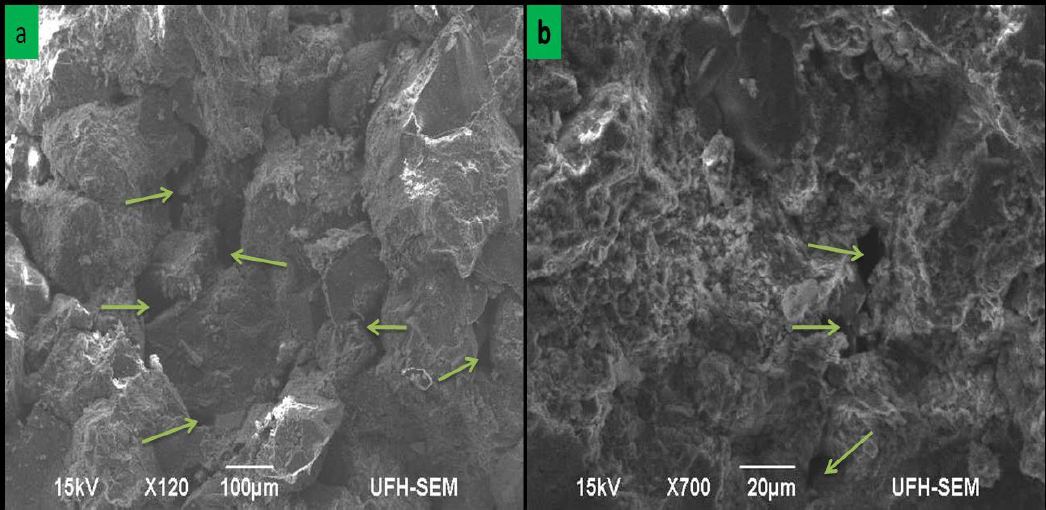
SEM images showing (a) primary intergranular pores in a sample from Clarens Formation (pointed by green arrows) (Sample Cd6d); and (b) secondary micro-pores from Elliot Formation (pointed by arrows) (Sample Cd6d).
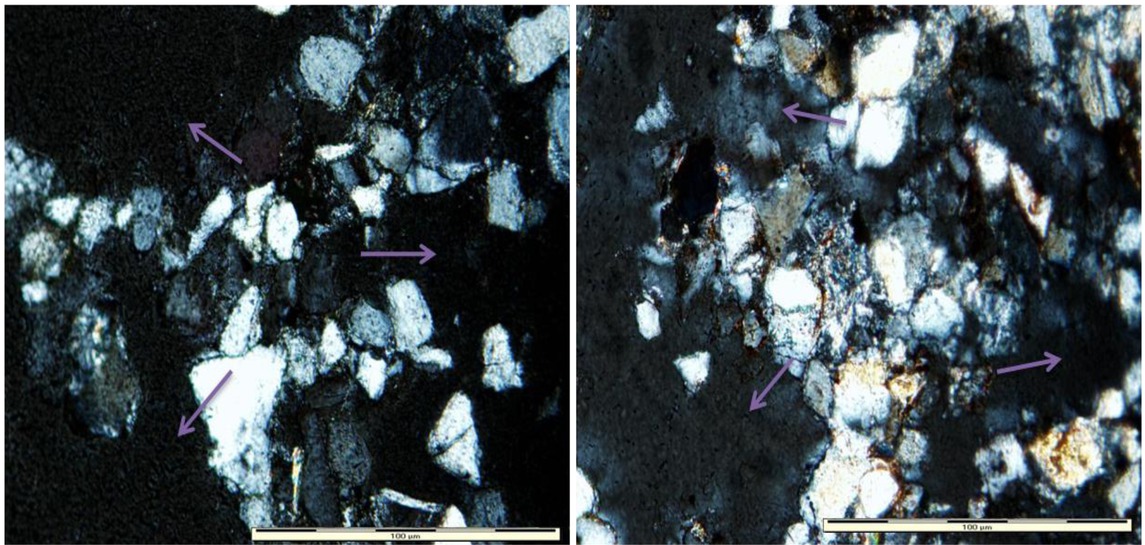
Photomicrographs showing a vast network of pores (dark areas indicated by arrows) (Sample Cd6d).
Diagenetic events and pathway of the Molteno, Elliot and Clarens Formations.
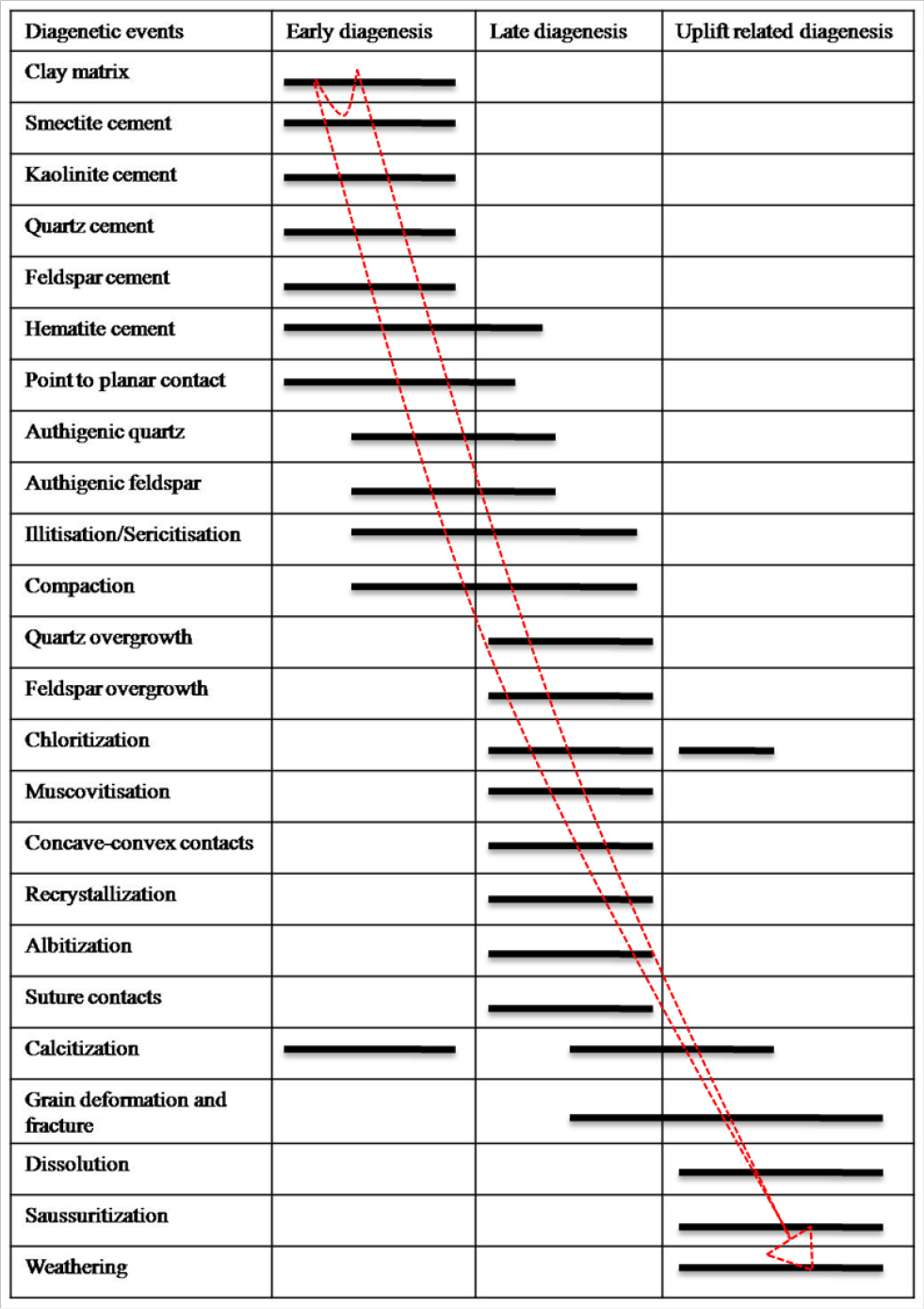 |
The analysed samples from the Elliot and Clarens Formations are moderately compacted, and also contain a moderate amount of cement and authigenic minerals. The distribution of cements is said to be highly dependant on changes of burial depth and the grain sizes. Under the microscope, it was observed that the Molteno Formation samples have lesser pore space network as compared to those from the Elliot and Clarens Formations, with the Clarens Formation samples having good pore network system. Fluid flow in sedimentary rocks is directly related to the porosity which also tends to greatly depend on the geometry of the pore space such as pore connectivity, pore distributions and even pore shapes. Grain size and abundance of authigenic minerals characterise the pore morphologies which tend to be modified by both cementation and authigenic mineral growth. Studies like [2, 36, 38, 44] have shown that grain size has very little influence on porosity even though an increase in grain size results in higher permeability. Also, size affects the surface area available for diagenetic reactions: the finer the grain size, the greater the grain surface area for a certain volume of sediment or rock. Sorting and porosity have a strong correlation in sandstones as it highlights the degree of how uniform the grain size is. Sorting influences reservoir quality in the sense that the better the sorting, the higher the porosity and permeability. Well-sorted sandstones tend to have a higher percentage of grains than poorly sorted sandstones, and they tend to maintain higher porosities during burial than poorly sorted sandstones. Poorly sorted sands tend to have more clay matrix, occupying the pore space. Most aeolian sediments tend to be well sorted and loosely packed thus have higher porosities. Figure 24 shows samples with different grain sizes and sorting.

Photomicrographs showing different grain shapes, sizes and sorting (a) Medium grained well sorted, sub-rounded sandstone from Molteno Formation (Sample Md9). (b) Medium grained well sorted, sub-rounded sandstone from Elliot Formation (Sample E6c). (c) Fine grained moderately sorted, sub-angular sandstone from Clarens Formation (Sample Cd6d).
Under the microscope, quartz overgrowths essentially mask the shape and roundness of detrital grains. Most of the grains appear to be sub-rounded and sub-angular shaped. The shape of sediments is depended on the distance of transportation. [49] documented that sediments composed of spherical grains tend to have lower porosities than those with grains of lower sphericity. It is mainly because the spherical grains tend to fall into a tighter packing than sands of lower sphericity. Dissolution of quartz and feldspars (mostly plagioclases) created a secondary porosity and enhanced the porosity of the Molteno, Elliot and Clarens Formations rocks. However, this secondary porosity was partially to completely filled by calcite and chlorite cements, especially in the Molteno and Elliot Formations. Very high clay content tends to have adverse effect on reservoir quality. In addition, kaolinite cement can retain up to 20% porosity and permeability when the crystal plates are not randomly stacked [50]. An upward increase of the clay minerals content in the fluvial channel filling sequence was due to a decrease in hydrodynamic energy during deposition and thus reduced porosity. It was observed that secondary porosities within the samples are associated with the dissolution of quartz grains and feldspars and the micro porosity is associated with clays and these are mostly dominant in the Elliot and Clarens Formations.
6 Conclusions
This study has shown that the main diagenetic processes that have affected the rocks are cementation, compaction, recrystallization, replacement, mineral overgrowth and dissolution. The early diagenetic stage facilitated much of the cementation, mineral conversions and authigenic minerals, while quartz and feldspar overgrowths, compaction, chloritization, muscovitization, concave-convex contacts, recrystallization, albitization and suture contacts are present in the late diagenetic stage. Calcitization, grain deformation and fracturing, dissolution, saussuritization and weathering affected the uplift-related diagenetic stage. SEM-EDX and XRD analyses have identified seven types of cements which are smectite, kaolinite, hematite, calcite, quartz, feldspar and chlorite cements. Calcite cementation is also common in the Elliot and Clarens sandstones that are as a result of strong evaporation process in an arid to semi-arid climate, and in turn tend to cement the grains and reduce their porosity. Primary and secondary porosities were both observed in the studied Stormberg Group sandstones. The primary pores are formed during sedimentation process, whereas secondary pores developed during diagenesis as a result of dissolution of less stable minerals or clastic grains and cements, as well as structural forcing and differential compaction (i.e. fracture pores). In general, there is no single diagenetic process that is primarily controlling the pattern of porosity evolution in the sandstones. However, it appears that the main types of cements and compaction jointly controlled the reservoir quality of the sandstones. Mechanical compaction and authigenic cements reduce porosity and permeability. Onthe other hand, the presence of fractured and dissolution pores tend to enhance reservoir quality. Grain fracturing is also common in the sandstones of the Molteno and Elliot Formations. This could be due to excessive burial compaction and these cracks tend to improve secondary porosity and permeability of reservoir rocks. Clarens Formation sandstones characteristically have the greatest pore network system and most of these pores are noted to be primary intergranular pores. All the aforementioned diagenetic processes largely affect porosity and permeability of the groundwater and mineral reservoir rock properties.
Acknowledgement
The authors thank the DST-NRF Centre of Excellence for Intergrated Mineral and Energy Resource Analysis (CIMERA) and the Govan Mbeki Research and Development Centre (GMRDC) of the University of Fort Hare for financial support.
Conflict of Interest
Conflict of Interests: The authors declare that they have no conflicts of interest.
References
[1] Worden, R.H., Burley, S.D., Sandstone diagenesis: the evolution of sand to stone. In S.D. Burley and R.H. Worden (Eds.), Sandstone diagenesis: recent and ancient. International Association of Sedimentologists Special Publication, 4, Blackwell, Oxford, 2003, 3-44.10.1002/9781444304459Search in Google Scholar
[2] Baiyegunhi, C., Liu, K., Gwavava, O., Diagenesis and reservoir properties of the Permian Ecca Group sandstones and mudrocks in the Eastern Cape Province, South Africa. Minerals, 2017, 88 (7), 1-26.10.3390/min7060088Search in Google Scholar
[3] Sciscio, L., Position of the Triassic-Jurassic boundary in South Africa and Lesotho: A multidisciplinary approach aimed at improving the chronostratigraphy and biostratigraphy of the Elliot Formation, Stormberg Group. PhD thesis, University of Cape Town, South Africa, 2015, 301pp.Search in Google Scholar
[4] Ajdukiewicz, J.M., Lander, R.H., Sandstone reservoir quality prediction: the state of the art. American Association of Petroleum Geologists Bulletin, 2010, 94 (8), 1083-1091.10.1306/intro060110Search in Google Scholar
[5] Makeen, Y.M., Abdullah, W.H., Ayinla, H.A., Hakimi, M. H., Sia, S.G., Sedimentology, diagenesis and reservoir quality of the upper Abu Gabra Formation sandstones in the Fula Sub-basin, Muglad Basin, Sudan. Marine and Petroleum Geology, 2016, 77, 1227-1242.10.1016/j.marpetgeo.2016.08.015Search in Google Scholar
[6] Morad, S., Al-Ramadan, K., Ketzer, J.M., DeRos, L.F., The impact of diagenesis on the heterogeneity of sandstone reservoirs: a review of the role of depositional facies and sequence stratigraphy. American Association of Petroleum Geologists Bulletin, 2010, 94, 1267-1309.10.1306/04211009178Search in Google Scholar
[7] Zhang, L., Guo, X.S., Hao, F., Zou, H.Y., Li, P.P., Lithologic characteristics and diagenesis of the Upper Triassic Xujiahe formation, Yuanba area, northeastern Sichuan Basin. Journal of Natural Gas Science and Engineering, 2016, 35, 1320-1335.10.1016/j.jngse.2016.09.067Search in Google Scholar
[8] Zhou, X., He, S., Chen, Z., Wang, F., Zhou, S., Liu, P., Diagenesis and diagenetic facies of low porosity and permeability sandstone inMember 8 of the Yanchang Formation in Daijiaping area, Ordos Basin. Oil Gas Geology, 2016, 37 (2), 155-164.Search in Google Scholar
[9] Reed, J.S., Eriksson, K.A., Kowalewski, M., Climatic, depositional and burial controls on diagenesis of Appalachian Carboniferous sandstones: qualitative and quantitative methods. Sedimentary Geology, 2005, 176, 225-246.10.1016/j.sedgeo.2004.11.003Search in Google Scholar
[10] Macquaker, J.H.S., Taylor, K.G., Keller, M., Polya, D., Compositional controls on early diagenetic pathways in fine-grained sedimentary rocks: Implications for predicting unconventional reservoir attributes of mudstones. American Association of Petroleum Geologists Bulletin, 2014, 93, 587-603.10.1306/08201311176Search in Google Scholar
[11] Molenaar, N., Origin of low-permeability calcite-cemented lenses in shallow marine sandstones and CaCO3 cementation mechanisms, an example from the Lower Jurassic Luxemburg sandstones, Luxemburg. In: S. Morad (Ed.). Carbonate cementation in sandstones. International Association of Sedimentologists Special Publication, 1998, 26, 193-211.10.1002/9781444304893.ch9Search in Google Scholar
[12] Bordy, E. M., Eriksson, P., Lithostratigraphy of the Elliot Formation (Karoo Supergroup), South Africa. South African Journal of Geology, 18(3), 311-316.10.2113/gssajg.118.3.311Search in Google Scholar
[13] Le Roux, J. P. (1990). Uranium mineralization in the Molteno and Elliot formations. South African Journal of Geology, 2015, 93, 738-743.Search in Google Scholar
[14] Cole, D.I., Smith, R.M.H., Fluvial architecture of the Late Permian Beaufort Group deposits, S.W. Karoo Basin: Point bars, crevasse splays, paleosols, vertebrate fossils and uranium. Field Excursion Guidebook, American Association of Petroleum Geologists International Conference, Cape Town, 2008, FT02, 1-110.Search in Google Scholar
[15] Catuneanu, O., Hancox, P.J., Rubidge, B.S., Reciprocal flexural behavior and contrasting stratigraphies: A new basin development model for the Karoo retroarc foreland system, South Africa. Basin Research, 1998, 10, 417-439.10.1046/j.1365-2117.1998.00078.xSearch in Google Scholar
[16] Milani, E.J., de Wit M.J., Correlations between the classic Paraná and Cape Karoo sequences of South America and southern Africa and their basin infills flanking the Gondwanides: du Toit revisited. In: R.J. Pankurst, R.A.J. Trouw, B.B. Brito Neves, and M.J. de Wit (Eds.). West Gondwana: Pre-Cenozoic Correlations across the South Atlantic Region. Geological Society of London Special Publications, 2008,294, 319-342.Search in Google Scholar
[17] Linol, B., de Wit, M.J., Barton, E., Guillocheau, F., de Wit, M.J.C., Colin J.P., Chapter 7a: Paleogeography and tectono-stratigraphy of Carboniferous-Permian and Triassic ‘Karoo-like’ sequences of the Congo Basin. In: de Wit, M.J., Guillocheau, F., de Wit, M.J.C. (Eds.). The Geology and Resource Potential of the Congo Basin, Regional Geology Reviews, Springer-Verlag, 2015, 111-134.Search in Google Scholar
[18] Catuneanu, O., Wopfner, H., Eriksson, P.G., Cairncross, B., Rubidge, B.S., Smith, R.M.H., Hancox, P.J., The Karoo basins of south-central Africa. Journal of African Earth Sciences, 2005, 43, 211-253.10.1016/j.jafrearsci.2005.07.007Search in Google Scholar
[19] Aarnes, I., Svensen, H., Conolly, J.A.D., Podladchikov, Y.Y., How contact metamorphism can trigger global climate changes: Modeling gas generation around igneous sills in sedimentary basins. Geochimica et Cosmochimica Acta, 2010, 74, 7179-7195.10.1016/j.gca.2010.09.011Search in Google Scholar
[20] Cole, D.I., Evolution and development of the Karoo Basin. In: M.J. de Wit and I.D.G. Ransome, (Eds.). Inversion Tectonics of the Cape Fold Belt, Karoo and Cretaceous Basins of Southern Africa, Balkema, Rotterdam, Netherlands, 1992, 87-99.Search in Google Scholar
[21] Rubidge, B.S., Biostratigraphy of the Beaufort Group (Karoo Supergroup), South Africa, 1. South African Committee for Stratigraphy, SACS Biostratigraphic Series, Council for Geoscience, 1995, 40-46.Search in Google Scholar
[22] Smith, R.M.H., Eriksson, P.G., Botha, W.J., A review of the stratigraphy and sedimentary environments of the Karoo-aged basins of Southern Africa. Journal of African Earth Sciences, 1993, 132 (16), 143-169.10.1016/0899-5362(93)90164-LSearch in Google Scholar
[23] Tankard, A., Welsink, H., Aukes, P., Newton, R., Stettler, E., Tectonic evolution of the Cape and Karoo basins of South Africa. Marine and Petroleum Geology, 2009, 26, 1379-1412.10.1016/j.marpetgeo.2009.01.022Search in Google Scholar
[24] Johnson, M.R., van Vuuren, C.J., Visser, J.N.J., Cole, D.I., Wickens, H. DeV, Christie, A.D.M., Roberts, D.L., Brandl, G., Sedimentary rocks of the Karoo Supergroup. In: M. R. Johnson, C. R. Anhaeusser and R. J. Thomas (Eds.). The Geology of South Africa, Geological Society of South Africa and Council for Geoscience, 2006, 461-499.Search in Google Scholar
[25] Turner, B.R., The stratigraphy and sedimentary history of the Molteno Formation in the Main Karoo Basin of South Africa and Lesotho. Ph.D. thesis (unpubl.), Univ. Witwatersrand, 1975, 314pp.Search in Google Scholar
[26] Johnson, M.R., Stratigraphy and sedimentology of the Cape and Karoo sequences in the Eastern Cape. PhD Thesis (Unpublished). Rhodes University, Grahamstown, South Africa, 1976, 267pp.Search in Google Scholar
[27] Robinson, D.N., Beer, H. M., Nutsch, F.M., Trumpelmen, F., The geology and oil potential of the Stormberg Group. (Unpublished) Report, Soekor, Johannesburg, 1969.Search in Google Scholar
[28] Bordy, E. M., Hancox, P. J., Rubidge, B. S., Fluvial style variations in the Late Triassic - Early Jurassic Elliot Formation, main Karoo Basin, South Africa. Journal of African Earth Sciences, 2004, 38, 383-400.10.1016/j.jafrearsci.2004.02.004Search in Google Scholar
[29] Smith, R.M.H., Kitching, J., Sedimentology and vertebrate taphonomy of the Tritylodon Acme Zone: a reworked palæosol in the Lower Jurassic Elliot Formation, Karoo Supergroup, South Africa. Paleogeography, Paleoclimatology, Paleoecology, 1997, 131, 29-50.10.1016/S0031-0182(96)00143-5Search in Google Scholar
[30] Visser, J.N.J., Botha, B.J.V., Meander belt, point bar, crevasse splay and aeolian deposits from the Elliot Formation in Barkly Pass, northeastern Cape. Transactions of the Geological Society of South Africa, 1980, 83, 55-62.Search in Google Scholar
[31] Stockley, G.M., Report on the Geology of Basutoland. Basutoland Government, Maseru, 1947.Search in Google Scholar
[32] Botha, B.J.V., The stratigraphy of the Red Beds Stage, Karroo System at Elliot, Cape Province. Transactions of the Geological Society of South Africa, 1968, 71, 101-117.Search in Google Scholar
[33] Johnson, M.R., van Vuuren, C.J., Hegenberger, W.F., Key, R., Shoko, U., Stratigraphy of the Karoo Supergroup in southern Africa: an overview. Journal of African Earth Sciences, 1996, 23, 3-15.10.1016/S0899-5362(96)00048-6Search in Google Scholar
[34] Smith, R.M.H., A review of the stratigraphy and sedimentary environments of the Karoo basin of South Africa. Journal of African Earth Sciences, 1990, 10, 117-137.10.1016/0899-5362(90)90050-OSearch in Google Scholar
[35] Blatt, H., Petrology, igneous, sedimentary and metamorphic. San Francisco, Freeman, 1982, 732pp.Search in Google Scholar
[36] Gaupp, R., Okkerman, J., Diagenesis and reservoir quality of Rotliegend sandstones in the Northern Netherlands — a review. In: Grötsch, J., Gaupp, R. (Eds.), the Permian Rotliegend of the Netherlands. SEPM Special Publication, Tulsa, Oklahoma, U.S.A., 2011, 193-226.10.2110/pec.11.98.0193Search in Google Scholar
[37] Ozturk, C.A., Nasuf, E., Kahraman, S., Estimation of rock strength from quantitative assessment of rock texture. The Journal of the Southern African Institute of Mining and Metallurgy, 2014, 114, 471-480.Search in Google Scholar
[38] Schultz, R.A., Okubo, C.H., Fossen, H., Porosity and grain size controls on compaction band formation in Jurassic Navajo Sandstone. Geophysical Research Letters, 2010, 37 (L22306), 1-5.10.1029/2010GL044909Search in Google Scholar
[39] Lander, R.H., Walderhaug, O., Predicting porosity through simulating sandstone compaction and quartz cementation. American Association of Petroleum Geologists Bulletin, 1999, 83(3), 433-449.Search in Google Scholar
[40] Boggs, S.J., Principles of Sedimentology and Stratigraphy, Pearson Education, Inc., 2014, 564pp.Search in Google Scholar
[41] Hu, X., Huang, S., Physical properties of reservoir rocks. Springer Geophysics, Petroleum Industry Press and Springer-Verlag Berlin Heidelberg, 2017, 159pp.10.1007/978-3-662-55026-7_2Search in Google Scholar
[42] McBride, E.F., Quartz cement in sandstones: a review. Earth-Science Reviews, 1989, 26, 69-112.10.1016/0012-8252(89)90019-6Search in Google Scholar
[43] Pettijohn, F.J., Potter, P.E. and Siever, R., Sand and Sandstone. Springer, New York, 1987, 553pp.10.1007/978-1-4612-1066-5Search in Google Scholar
[44] Ahmed, W., Contrast in clay mineralogy and their effect on reservoir properties in sandstone formations. Bulletin Chemical Society of Ethiopia, 2008, 22(1), 41-65.10.4314/bcse.v22i1.61333Search in Google Scholar
[45] Xie, X., Jiao, J.J., Li, S., Cheng, J., Salinity variation of formation water and diagenesis reaction in abnormal pressure environments. Science in China Series D Earth Sciences, 2003, 46(3), 269-284.10.1360/03yd9025Search in Google Scholar
[46] Chen G., Du G., Zhang G., Wang Q., Lv C., Chen J., Chlorite cement and its effect on the reservoir quality of sandstones from the Panyu low-uplift, Pearl River Mouth Basin. Petroleum Science, 2011, 8, 143-150.10.1007/s12182-011-0127-zSearch in Google Scholar
[47] Erikkson, P.G., A palaeoenvironmental study of the Molteno, Elliot and Clarens Formations in the Natal Drakensberg and Northeastern Orange Free State. Unpublished PhD Thesis. University of Natal. Pietermaritzburg, 1983, 209pp.Search in Google Scholar
[48] Maynard, J.B.,Manganiferous sediments, rocks, and ores. Treatise on Geochemistry, 2003, 7, 289-308.10.1016/B0-08-043751-6/07099-7Search in Google Scholar
[49] Selley, R.C., Applied Sedimentology, Academic Press, USA, 2000, 128pp.Search in Google Scholar
[50] Rezaee, M.R., Lemon, N.M., Influence of depositional environment on diagenesis and reservoir quality: Tirrawarra sandstone reservoir, Southern Cooper Basin, Australia. Journal of Petroleum Geology, 1996, 19 (4), 369-391.10.1111/j.1747-5457.1996.tb00445.xSearch in Google Scholar
© 2018 P. Chima et al., published by De Gruyter
This work is licensed under the Creative Commons Attribution-NonCommercial-NoDerivatives 4.0 License.
Articles in the same Issue
- Regular Articles
- Spatio-temporal monitoring of vegetation phenology in the dry sub-humid region of Nigeria using time series of AVHRR NDVI and TAMSAT datasets
- Water Quality, Sediment Characteristics and Benthic Status of the Razim-Sinoie Lagoon System, Romania
- Provenance analysis of the Late Triassic Yichuan Basin: constraints from zircon U-Pb geochronology
- Historical Delineation of Landscape Units Using Physical Geographic Characteristics and Land Use/Cover Change
- ‘Hardcastle Hollows’ in loess landforms: Closed depressions in aeolian landscapes – in a geoheritage context
- Geostatistical screening of flood events in the groundwater levels of the diverted inner delta of the Danube River: implications for river bed clogging
- Utilizing Integrated Prediction Error Filter Analysis (INPEFA) to divide base-level cycle of fan-deltas: A case study of the Triassic Baikouquan Formation in Mabei Slope Area, Mahu Depression, Junggar Basin, China
- Architecture and reservoir quality of low-permeable Eocene lacustrine turbidite sandstone from the Dongying Depression, East China
- Flow units classification for geostatisitical three-dimensional modeling of a non-marine sandstone reservoir: A case study from the Paleocene Funing Formation of the Gaoji Oilfield, east China
- Umbrisols at Lower Altitudes, Case Study from Borská lowland (Slovakia)
- Modelling habitats in karst landscape by integrating remote sensing and topography data
- Mineral Constituents and Kaolinite Crystallinity of the <2 μm Fraction of Cretaceous-Paleogene/Neogene Kaolins from Eastern Dahomey and Niger Delta Basins, Nigeria
- Construction of a dynamic arrival time coverage map for emergency medical services
- Characterizing Seismo-stratigraphic and Structural Framework of Late Cretaceous-Recent succession of offshore Indus Pakistan
- Geosite Assessment Using Three Different Methods; a Comparative Study of the Krupaja and the Žagubica Springs – Hydrological Heritage of Serbia
- Use of discriminated nondimensionalization in the search of universal solutions for 2-D rectangular and cylindrical consolidation problems
- Trying to underline geotourist profile of National park visitors: Case study of NP Fruška Gora, Serbia (Typology of potential geotourists at NP Fruška Gora)
- Fluid-rock interaction and dissolution of feldspar in the Upper Triassic Xujiahe tight sandstone, western Sichuan Basin, China
- Calcified microorganisms bloom in Furongian of the North China Platform: Evidence from Microbialitic-Bioherm in Qijiayu Section, Hebei
- Spatial predictive modeling of prehistoric sites in the Bohemian-Moravian Highlands based on graph similarity analysis
- Geotourism starts with accessible information: the Internet as a promotional tool for the georesources of Lower Silesia
- Models for evaluating craters morphology, relation of indentation hardness and uniaxial compressive strength via a flat-end indenter
- Geotourism in an urban space?
- The first loess map and related topics: contributions by twenty significant women loess scholars
- Modeling of stringer deformation and displacement in Ara salt after the end of salt tectonics
- A multi-criteria decision analysis with special reference to loess and archaeological sites in Serbia (Could geosciences and archaeology cohabitate?)
- Speleotourism in Slovenia: balancing between mass tourism and geoheritage protection
- Attractiveness of protected areas for geotourism purposes from the perspective of visitors: the example of Babiogórski National Park (Poland)
- Implementation of Heat Maps in Geographical Information System – Exploratory Study on Traffic Accident Data
- Mapping War Geoheritage: Recognising Geomorphological Traces of War
- Numerical limitations of the attainment of the orientation of geological planes
- Assessment of runoff nitrogen load reduction measures for agricultural catchments
- Awheel Along Europe’s Rivers: Geoarchaeological Trails for Cycling Geotourists
- Simulation of Carbon Isotope Excursion Events at the Permian-Triassic Boundary Based on GEOCARB
- Morphometry of lunette dunes in the Tirari Desert, South Australia
- Multi-spectral and Topographic Fusion for Automated Road Extraction
- Ground-motion prediction equation and site effect characterization for the central area of the Main Syncline, Upper Silesia Coal Basin, Poland
- Dilatancy as a measure of fracturing development in the process of rock damage
- Error-bounded and Number-bounded Approximate Spatial Query for Interactive Visualization
- The Significance of Megalithic Monuments in the Process of Place Identity Creation and in Tourism Development
- Analysis of landslide effects along a road located in the Carpathian flysch
- Lithological mapping of East Tianshan area using integrated data fused by Chinese GF-1 PAN and ASTER multi-spectral data
- Evaluating the CBM reservoirs using NMR logging data
- The trends in the main thalweg path of selected reaches of the Middle Vistula River, and their relationships to the geological structure of river channel zone
- Lithostratigraphic Classification Method Combining Optimal Texture Window Size Selection and Test Sample Purification Using Landsat 8 OLI Data
- Effect of the hydrothermal activity in the Lower Yangtze region on marine shale gas enrichment: A case study of Lower Cambrian and Upper Ordovician-Lower Silurian shales in Jiangye-1 well
- Modified flash flood potential index in order to estimate areas with predisposition to water accumulation
- Quantifying the scales of spatial variation in gravel beds using terrestrial and airborne laser scanning data
- The evaluation of geosites in the territory of National park „Kopaonik“(Serbia)
- Combining multi-proxy palaeoecology with natural and manipulative experiments — XLII International Moor Excursion to Northern Poland
- Dynamic Reclamation Methods for Subsidence Land in the Mining Area with High Underground Water Level
- Loess documentary sites and their potential for geotourism in Lower Silesia (Poland)
- Equipment selection based on two different fuzzy multi criteria decision making methods: Fuzzy TOPSIS and fuzzy VIKOR
- Land deformation associated with exploitation of groundwater in Changzhou City measured by COSMO-SkyMed and Sentinel-1A SAR data
- Gas Desorption of Low-Maturity Lacustrine Shales, Trassic Yanchang Formation, Ordos Basin, China
- Feasibility of applying viscous remanent magnetization (VRM) orientation in the study of palaeowind direction by loess magnetic fabric
- Sensitivity evaluation of Krakowiec clay based on time-dependent behavior
- Effect of limestone and dolomite tailings’ particle size on potentially toxic elements adsorption
- Diagenesis and rock properties of sandstones from the Stormberg Group, Karoo Supergroup in the Eastern Cape Province of South Africa
- Using cluster analysis methods for multivariate mapping of traffic accidents
- Geographic Process Modeling Based on Geographic Ontology
- Soil Disintegration Characteristics of Collapsed Walls and Influencing Factors in Southern China
- Evaluation of aquifer hydraulic characteristics using geoelectrical sounding, pumping and laboratory tests: A case study of Lokoja and Patti Formations, Southern Bida Basin, Nigeria
- Petrography, modal composition and tectonic provenance of some selected sandstones from the Molteno, Elliot and Clarens Formations, Karoo Supergroup, in the Eastern Cape Province, South Africa
- Deformation and Subsidence prediction on Surface of Yuzhou mined-out areas along Middle Route Project of South-to-North Water Diversion, China
- Abnormal open-hole natural gamma ray (GR) log in Baikouquan Formation of Xiazijie Fan-delta, Mahu Depression, Junggar Basin, China
- GIS based approach to analyze soil liquefaction and amplification: A case study in Eskisehir, Turkey
- Analysis of the Factors that Influence Diagenesis in the Terminal Fan Reservoir of Fuyu Oil Layer in the Southern Songliao Basin, Northeast China
- Gravity Structure around Mt. Pandan, Madiun, East Java, Indonesia and Its Relationship to 2016 Seismic Activity
- Simulation of cement raw material deposits using plurigaussian technique
- Application of the nanoindentation technique for the characterization of varved clay
- Verification of compressibility and consolidation parameters of varved clays from Radzymin (Central Poland) based on direct observations of settlements of road embankment
- An enthusiasm for loess: Leonard Horner in Bonn and Liu Tungsheng in Beijing
- Limit Support Pressure of Tunnel Face in Multi-Layer Soils Below River Considering Water Pressure
- Spatial-temporal variability of the fluctuation of water level in Poyang Lake basin, China
- Modeling of IDF curves for stormwater design in Makkah Al Mukarramah region, The Kingdom of Saudi Arabia
Articles in the same Issue
- Regular Articles
- Spatio-temporal monitoring of vegetation phenology in the dry sub-humid region of Nigeria using time series of AVHRR NDVI and TAMSAT datasets
- Water Quality, Sediment Characteristics and Benthic Status of the Razim-Sinoie Lagoon System, Romania
- Provenance analysis of the Late Triassic Yichuan Basin: constraints from zircon U-Pb geochronology
- Historical Delineation of Landscape Units Using Physical Geographic Characteristics and Land Use/Cover Change
- ‘Hardcastle Hollows’ in loess landforms: Closed depressions in aeolian landscapes – in a geoheritage context
- Geostatistical screening of flood events in the groundwater levels of the diverted inner delta of the Danube River: implications for river bed clogging
- Utilizing Integrated Prediction Error Filter Analysis (INPEFA) to divide base-level cycle of fan-deltas: A case study of the Triassic Baikouquan Formation in Mabei Slope Area, Mahu Depression, Junggar Basin, China
- Architecture and reservoir quality of low-permeable Eocene lacustrine turbidite sandstone from the Dongying Depression, East China
- Flow units classification for geostatisitical three-dimensional modeling of a non-marine sandstone reservoir: A case study from the Paleocene Funing Formation of the Gaoji Oilfield, east China
- Umbrisols at Lower Altitudes, Case Study from Borská lowland (Slovakia)
- Modelling habitats in karst landscape by integrating remote sensing and topography data
- Mineral Constituents and Kaolinite Crystallinity of the <2 μm Fraction of Cretaceous-Paleogene/Neogene Kaolins from Eastern Dahomey and Niger Delta Basins, Nigeria
- Construction of a dynamic arrival time coverage map for emergency medical services
- Characterizing Seismo-stratigraphic and Structural Framework of Late Cretaceous-Recent succession of offshore Indus Pakistan
- Geosite Assessment Using Three Different Methods; a Comparative Study of the Krupaja and the Žagubica Springs – Hydrological Heritage of Serbia
- Use of discriminated nondimensionalization in the search of universal solutions for 2-D rectangular and cylindrical consolidation problems
- Trying to underline geotourist profile of National park visitors: Case study of NP Fruška Gora, Serbia (Typology of potential geotourists at NP Fruška Gora)
- Fluid-rock interaction and dissolution of feldspar in the Upper Triassic Xujiahe tight sandstone, western Sichuan Basin, China
- Calcified microorganisms bloom in Furongian of the North China Platform: Evidence from Microbialitic-Bioherm in Qijiayu Section, Hebei
- Spatial predictive modeling of prehistoric sites in the Bohemian-Moravian Highlands based on graph similarity analysis
- Geotourism starts with accessible information: the Internet as a promotional tool for the georesources of Lower Silesia
- Models for evaluating craters morphology, relation of indentation hardness and uniaxial compressive strength via a flat-end indenter
- Geotourism in an urban space?
- The first loess map and related topics: contributions by twenty significant women loess scholars
- Modeling of stringer deformation and displacement in Ara salt after the end of salt tectonics
- A multi-criteria decision analysis with special reference to loess and archaeological sites in Serbia (Could geosciences and archaeology cohabitate?)
- Speleotourism in Slovenia: balancing between mass tourism and geoheritage protection
- Attractiveness of protected areas for geotourism purposes from the perspective of visitors: the example of Babiogórski National Park (Poland)
- Implementation of Heat Maps in Geographical Information System – Exploratory Study on Traffic Accident Data
- Mapping War Geoheritage: Recognising Geomorphological Traces of War
- Numerical limitations of the attainment of the orientation of geological planes
- Assessment of runoff nitrogen load reduction measures for agricultural catchments
- Awheel Along Europe’s Rivers: Geoarchaeological Trails for Cycling Geotourists
- Simulation of Carbon Isotope Excursion Events at the Permian-Triassic Boundary Based on GEOCARB
- Morphometry of lunette dunes in the Tirari Desert, South Australia
- Multi-spectral and Topographic Fusion for Automated Road Extraction
- Ground-motion prediction equation and site effect characterization for the central area of the Main Syncline, Upper Silesia Coal Basin, Poland
- Dilatancy as a measure of fracturing development in the process of rock damage
- Error-bounded and Number-bounded Approximate Spatial Query for Interactive Visualization
- The Significance of Megalithic Monuments in the Process of Place Identity Creation and in Tourism Development
- Analysis of landslide effects along a road located in the Carpathian flysch
- Lithological mapping of East Tianshan area using integrated data fused by Chinese GF-1 PAN and ASTER multi-spectral data
- Evaluating the CBM reservoirs using NMR logging data
- The trends in the main thalweg path of selected reaches of the Middle Vistula River, and their relationships to the geological structure of river channel zone
- Lithostratigraphic Classification Method Combining Optimal Texture Window Size Selection and Test Sample Purification Using Landsat 8 OLI Data
- Effect of the hydrothermal activity in the Lower Yangtze region on marine shale gas enrichment: A case study of Lower Cambrian and Upper Ordovician-Lower Silurian shales in Jiangye-1 well
- Modified flash flood potential index in order to estimate areas with predisposition to water accumulation
- Quantifying the scales of spatial variation in gravel beds using terrestrial and airborne laser scanning data
- The evaluation of geosites in the territory of National park „Kopaonik“(Serbia)
- Combining multi-proxy palaeoecology with natural and manipulative experiments — XLII International Moor Excursion to Northern Poland
- Dynamic Reclamation Methods for Subsidence Land in the Mining Area with High Underground Water Level
- Loess documentary sites and their potential for geotourism in Lower Silesia (Poland)
- Equipment selection based on two different fuzzy multi criteria decision making methods: Fuzzy TOPSIS and fuzzy VIKOR
- Land deformation associated with exploitation of groundwater in Changzhou City measured by COSMO-SkyMed and Sentinel-1A SAR data
- Gas Desorption of Low-Maturity Lacustrine Shales, Trassic Yanchang Formation, Ordos Basin, China
- Feasibility of applying viscous remanent magnetization (VRM) orientation in the study of palaeowind direction by loess magnetic fabric
- Sensitivity evaluation of Krakowiec clay based on time-dependent behavior
- Effect of limestone and dolomite tailings’ particle size on potentially toxic elements adsorption
- Diagenesis and rock properties of sandstones from the Stormberg Group, Karoo Supergroup in the Eastern Cape Province of South Africa
- Using cluster analysis methods for multivariate mapping of traffic accidents
- Geographic Process Modeling Based on Geographic Ontology
- Soil Disintegration Characteristics of Collapsed Walls and Influencing Factors in Southern China
- Evaluation of aquifer hydraulic characteristics using geoelectrical sounding, pumping and laboratory tests: A case study of Lokoja and Patti Formations, Southern Bida Basin, Nigeria
- Petrography, modal composition and tectonic provenance of some selected sandstones from the Molteno, Elliot and Clarens Formations, Karoo Supergroup, in the Eastern Cape Province, South Africa
- Deformation and Subsidence prediction on Surface of Yuzhou mined-out areas along Middle Route Project of South-to-North Water Diversion, China
- Abnormal open-hole natural gamma ray (GR) log in Baikouquan Formation of Xiazijie Fan-delta, Mahu Depression, Junggar Basin, China
- GIS based approach to analyze soil liquefaction and amplification: A case study in Eskisehir, Turkey
- Analysis of the Factors that Influence Diagenesis in the Terminal Fan Reservoir of Fuyu Oil Layer in the Southern Songliao Basin, Northeast China
- Gravity Structure around Mt. Pandan, Madiun, East Java, Indonesia and Its Relationship to 2016 Seismic Activity
- Simulation of cement raw material deposits using plurigaussian technique
- Application of the nanoindentation technique for the characterization of varved clay
- Verification of compressibility and consolidation parameters of varved clays from Radzymin (Central Poland) based on direct observations of settlements of road embankment
- An enthusiasm for loess: Leonard Horner in Bonn and Liu Tungsheng in Beijing
- Limit Support Pressure of Tunnel Face in Multi-Layer Soils Below River Considering Water Pressure
- Spatial-temporal variability of the fluctuation of water level in Poyang Lake basin, China
- Modeling of IDF curves for stormwater design in Makkah Al Mukarramah region, The Kingdom of Saudi Arabia

